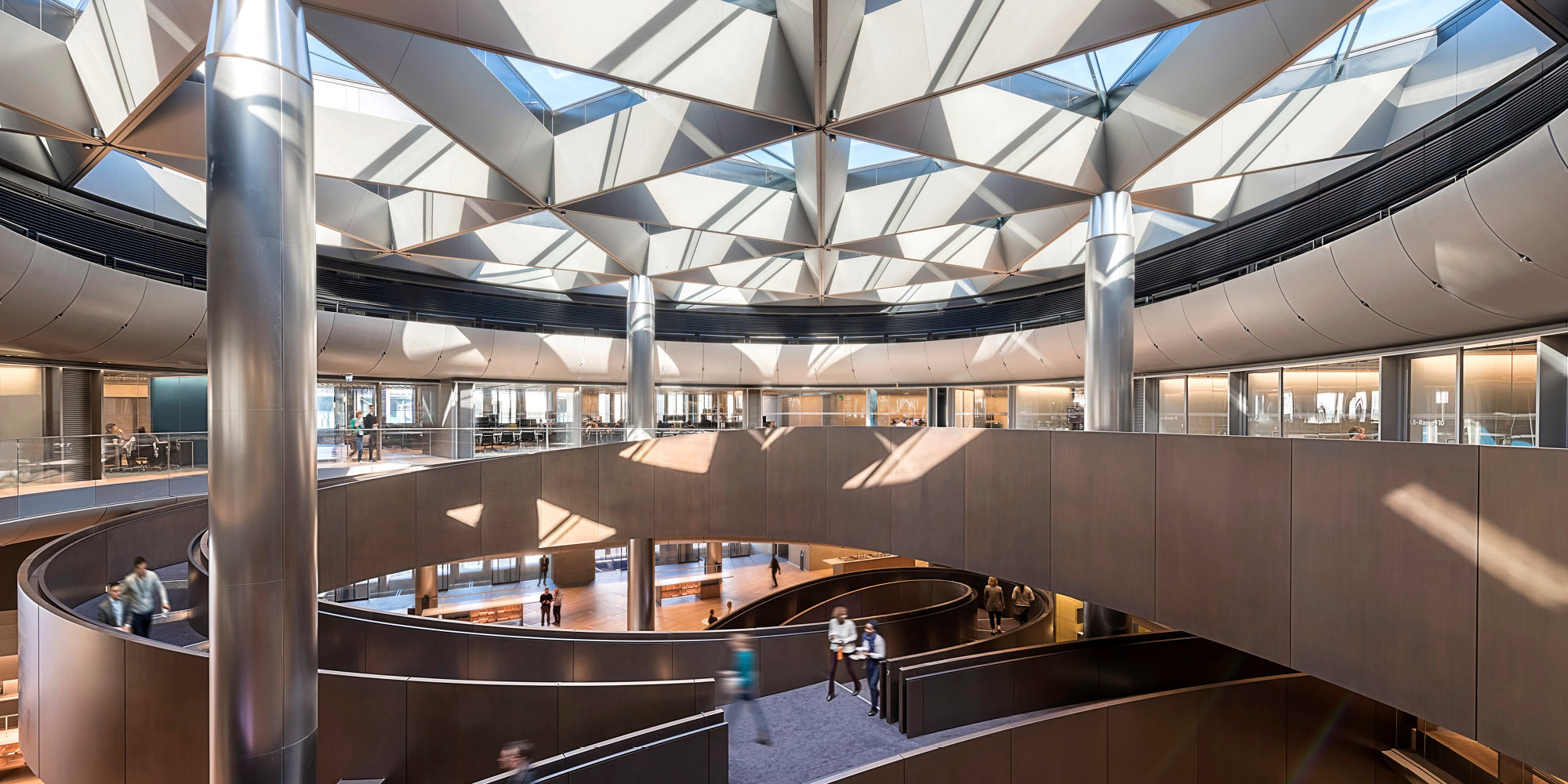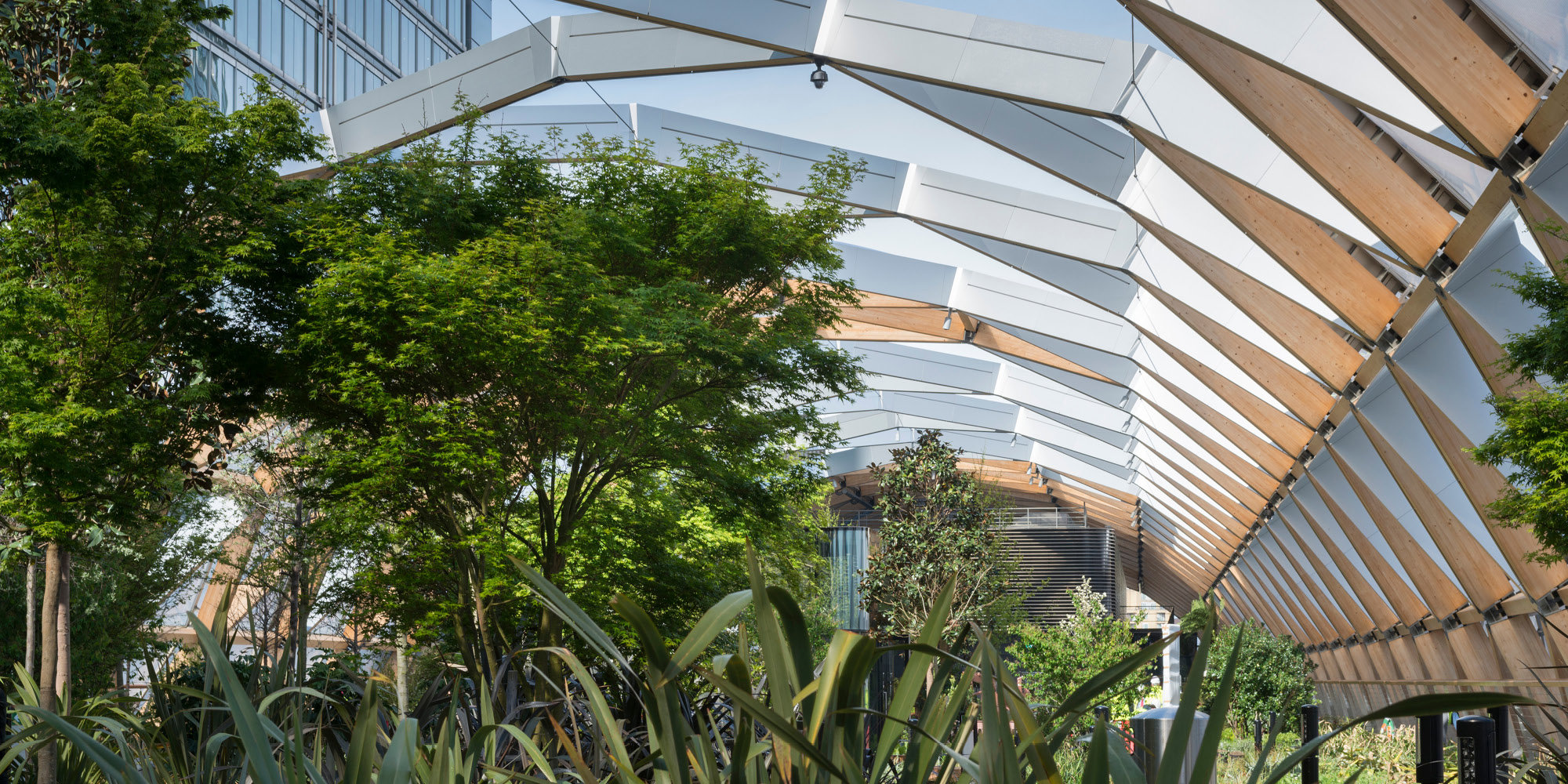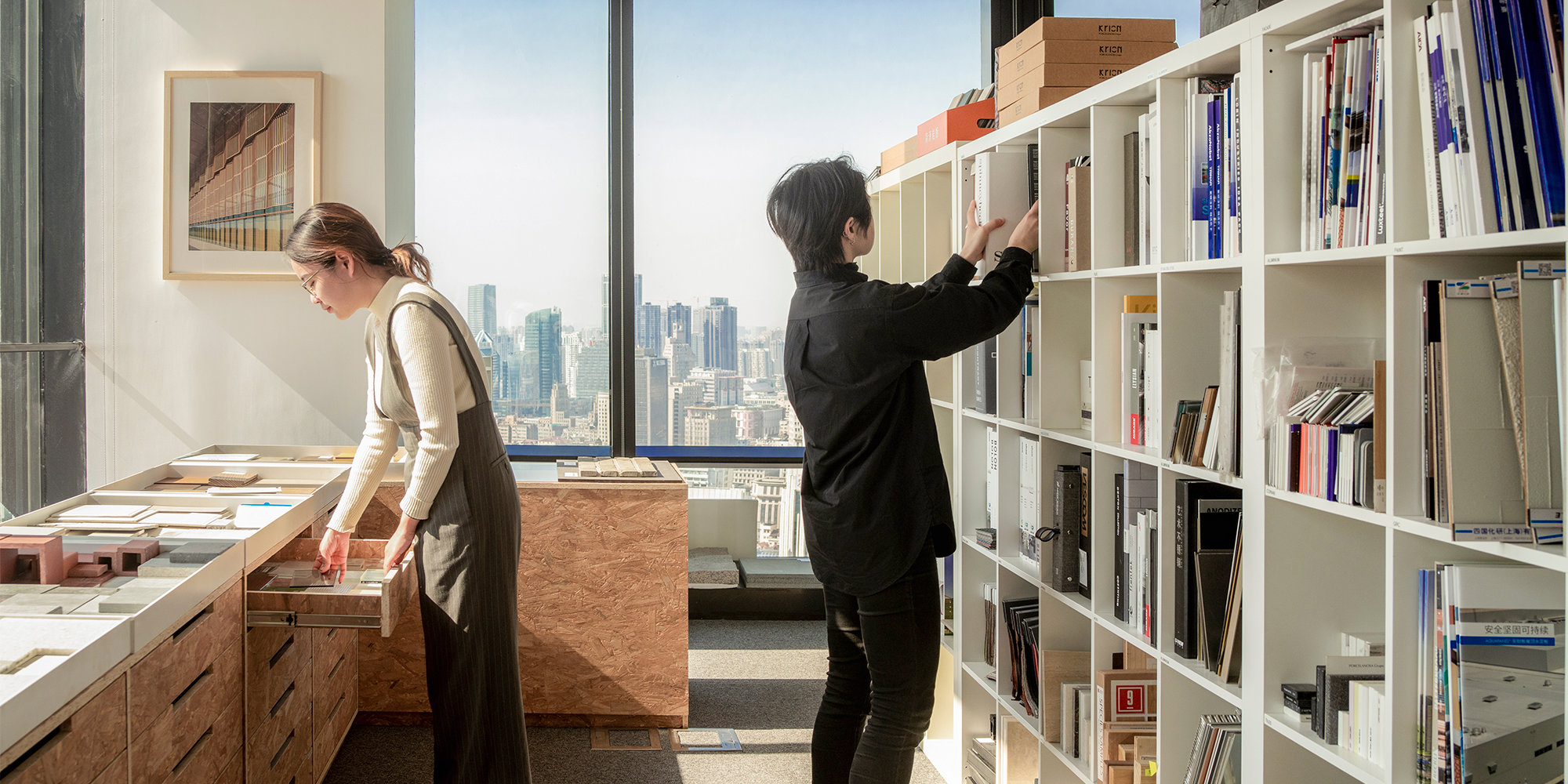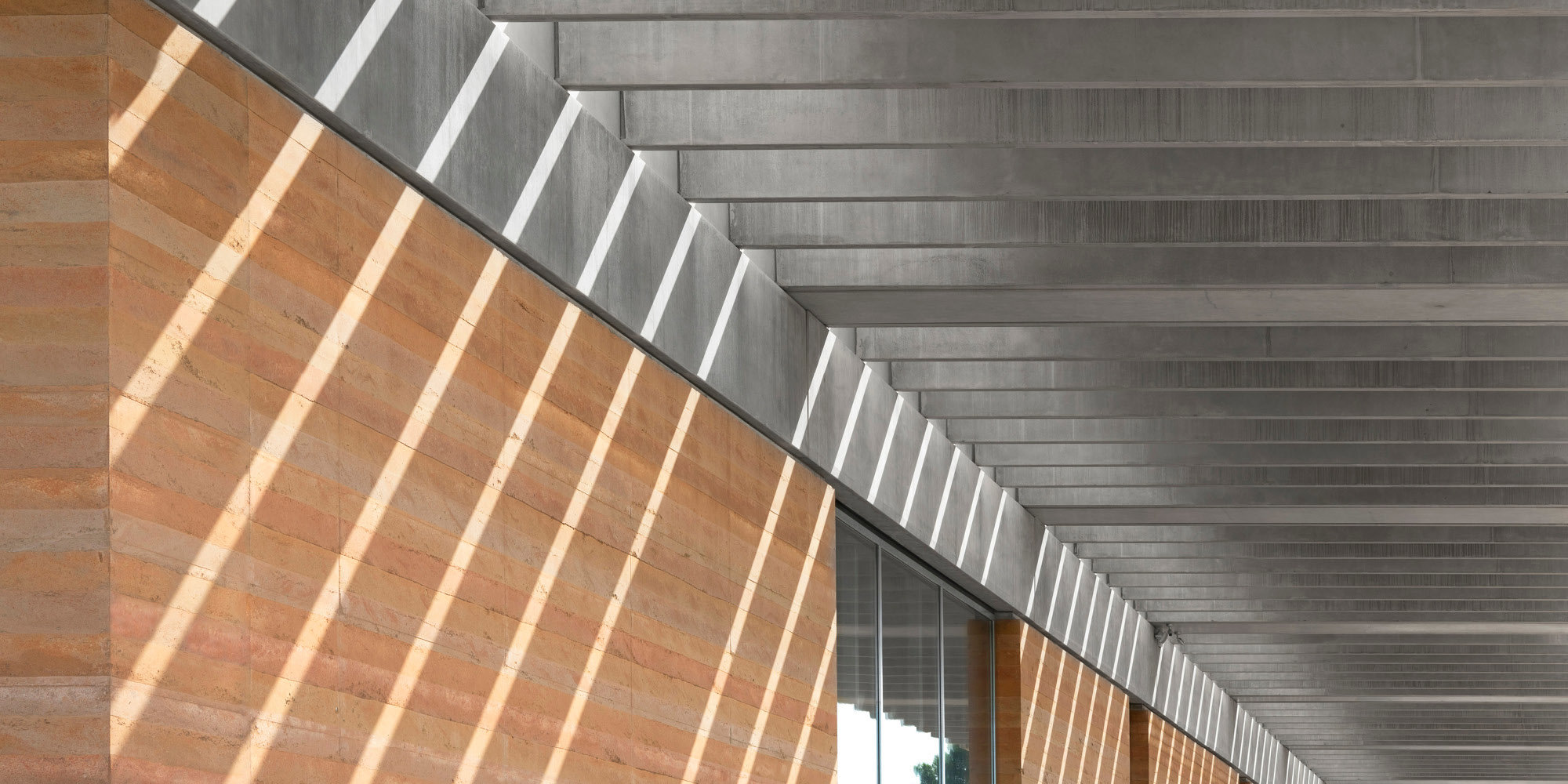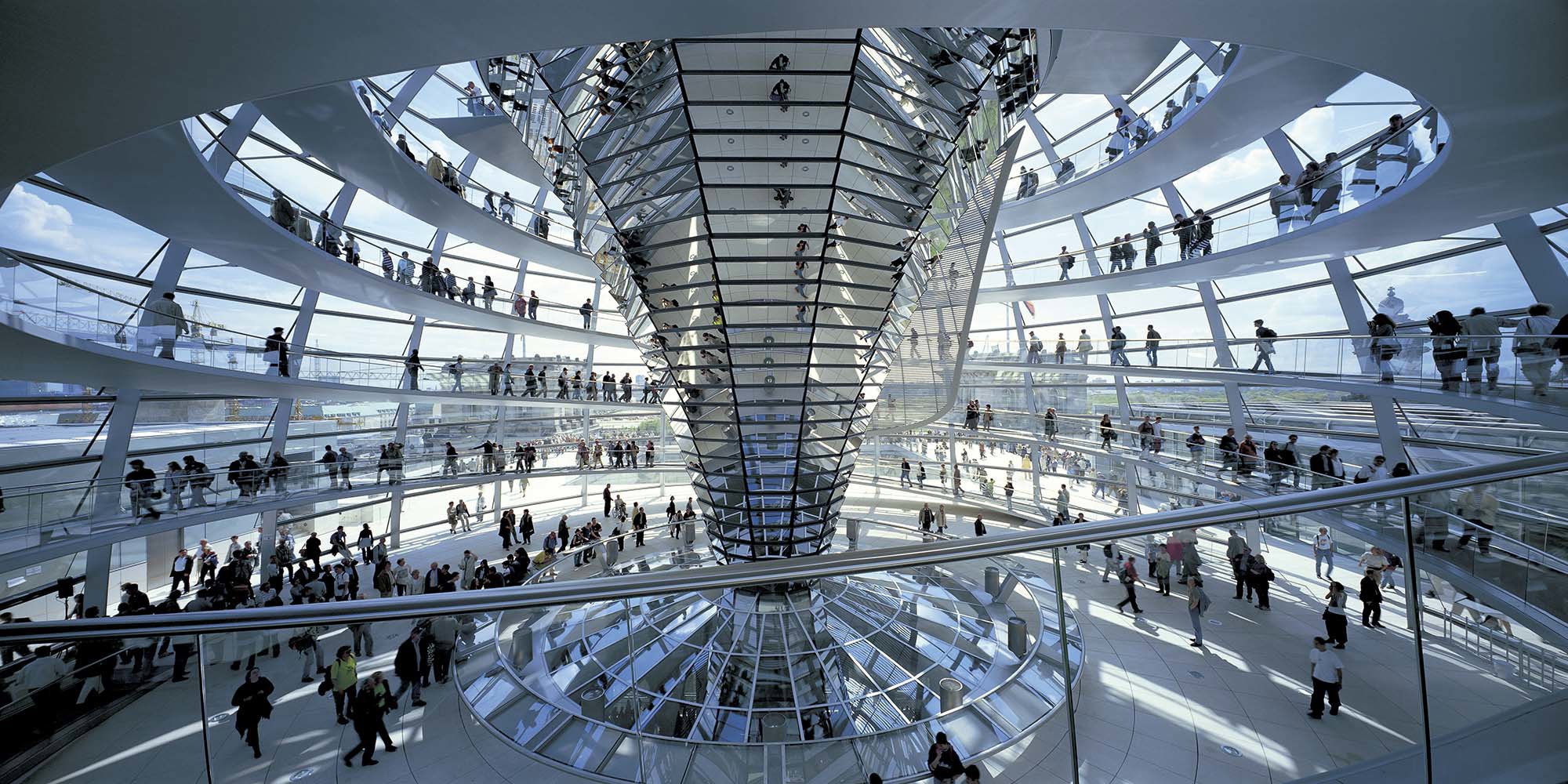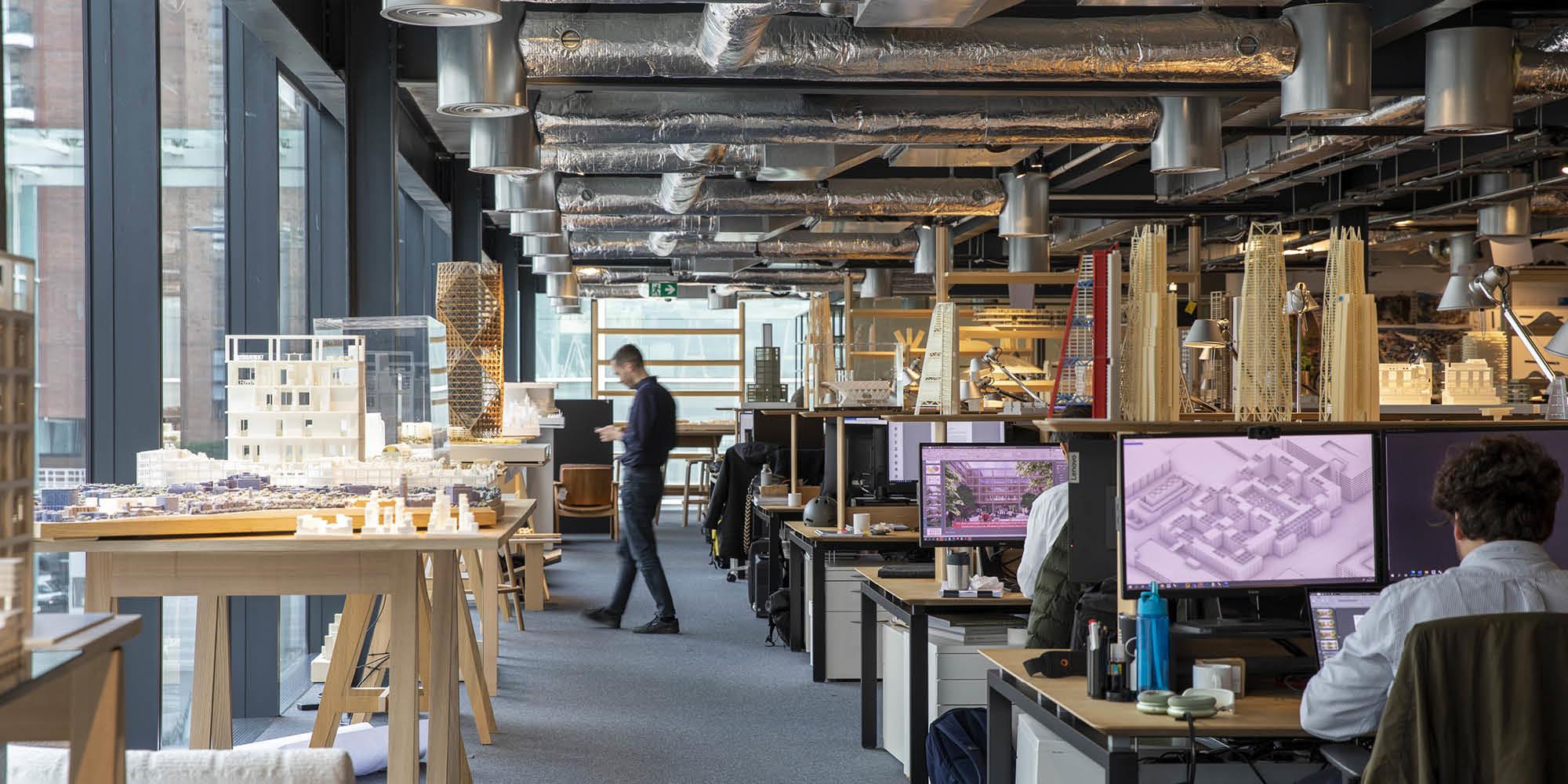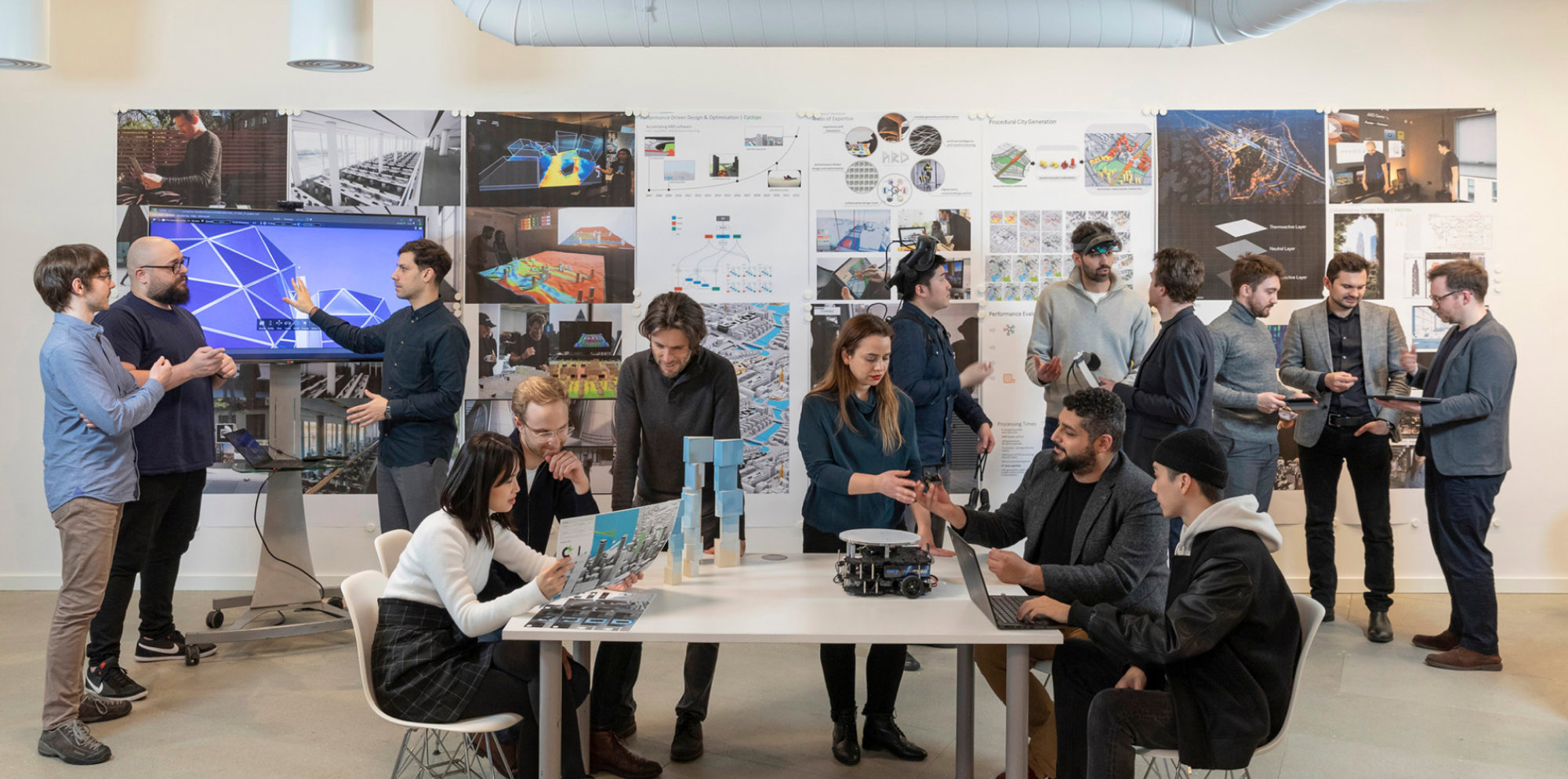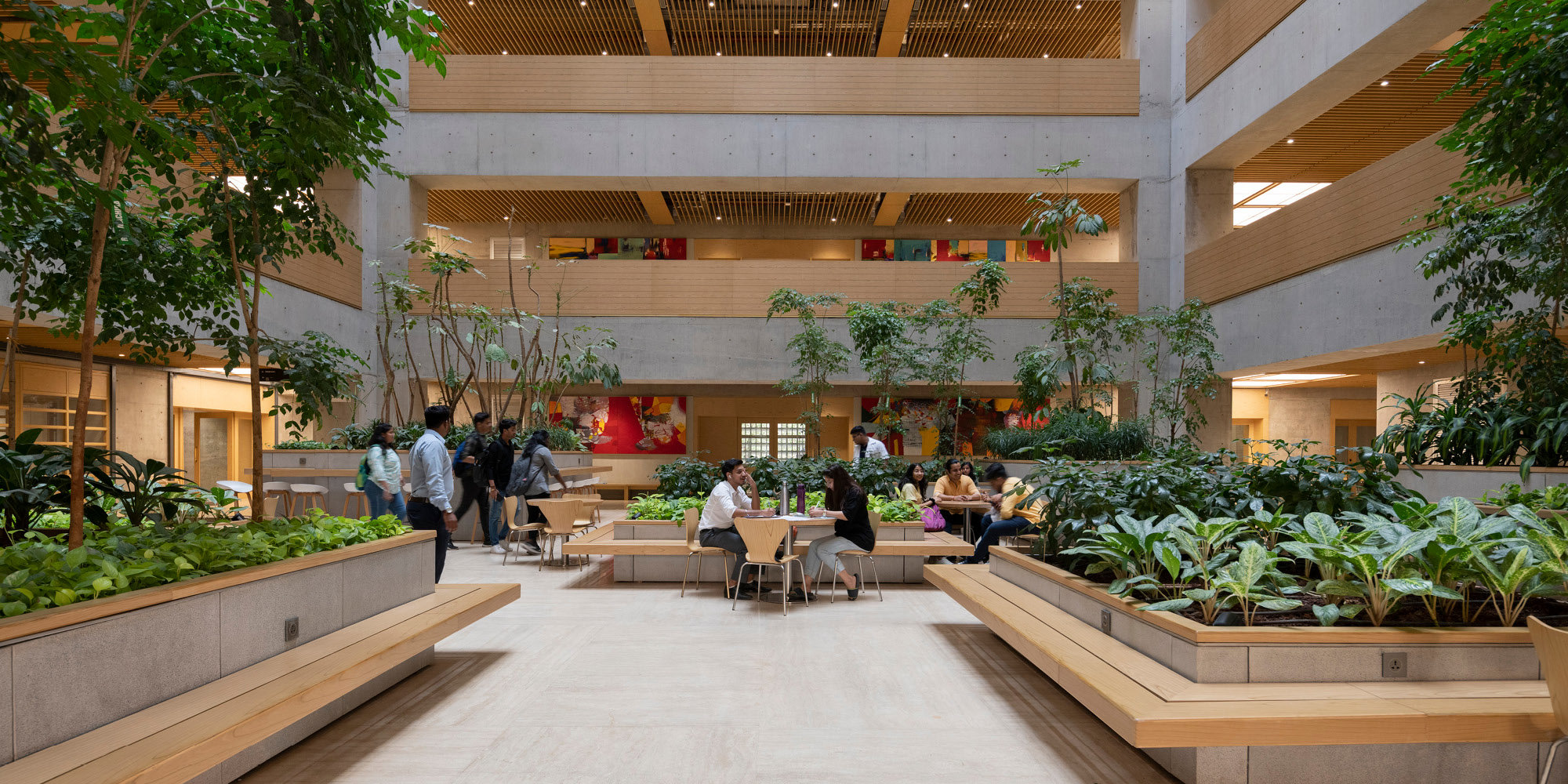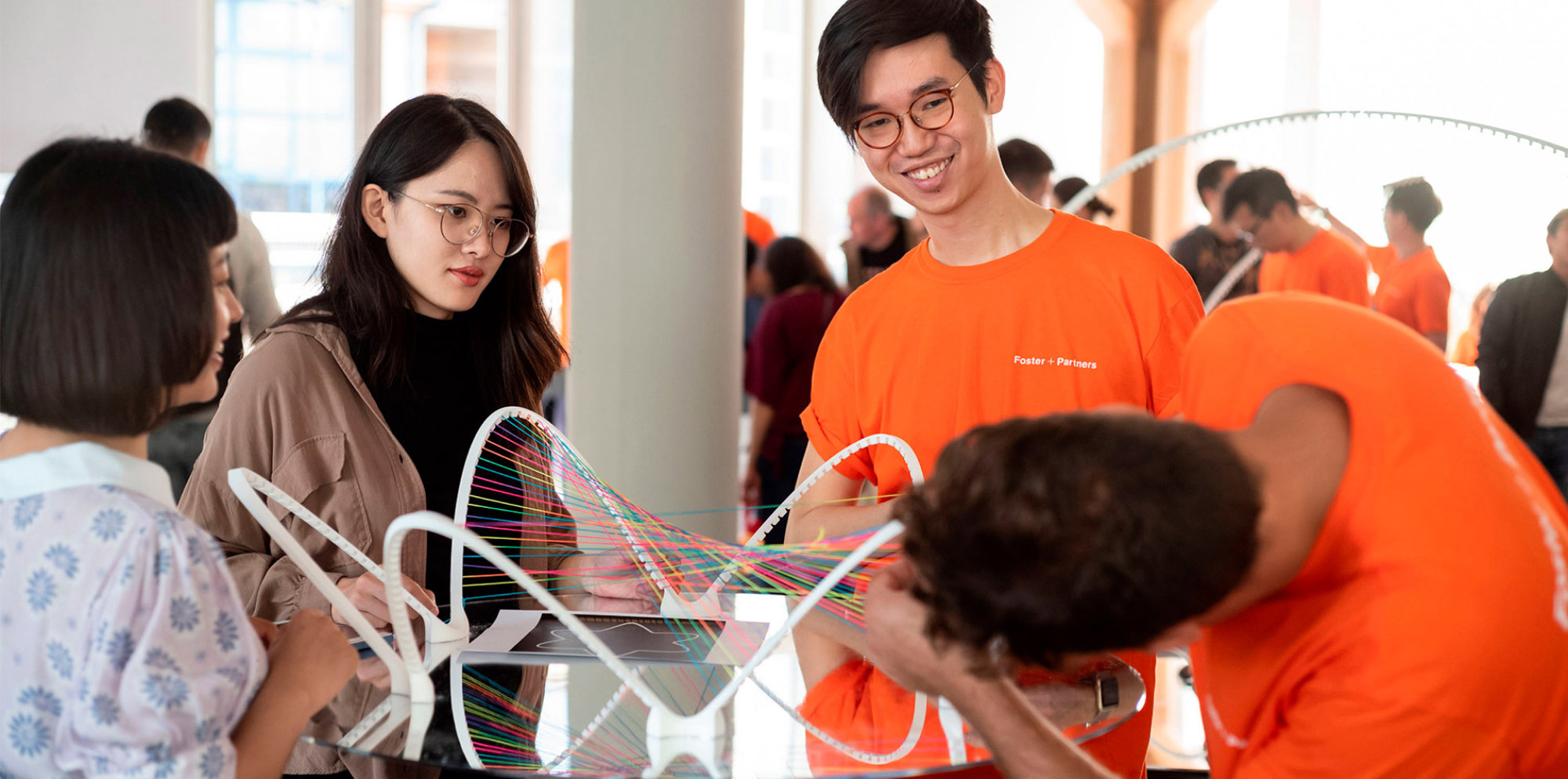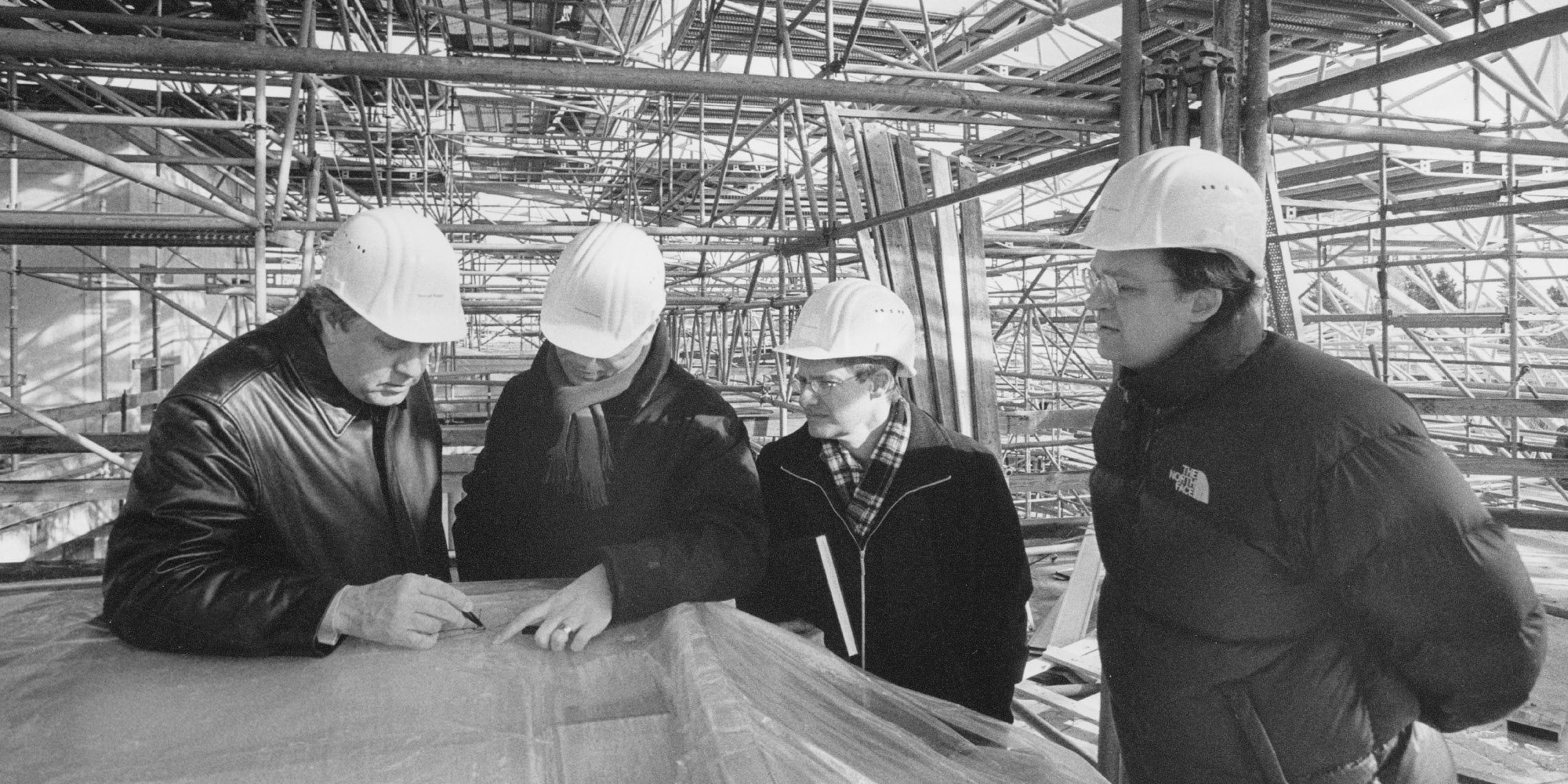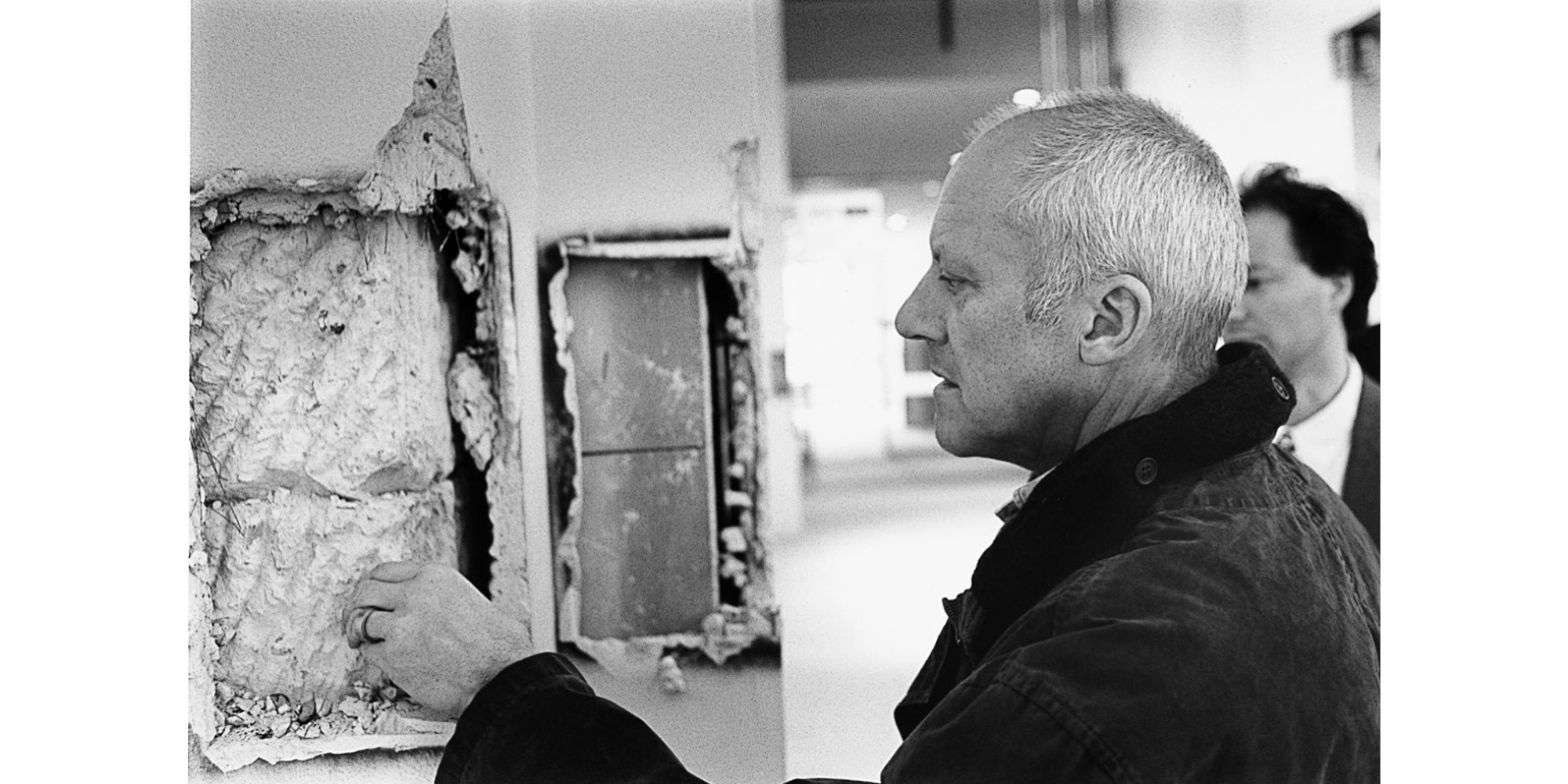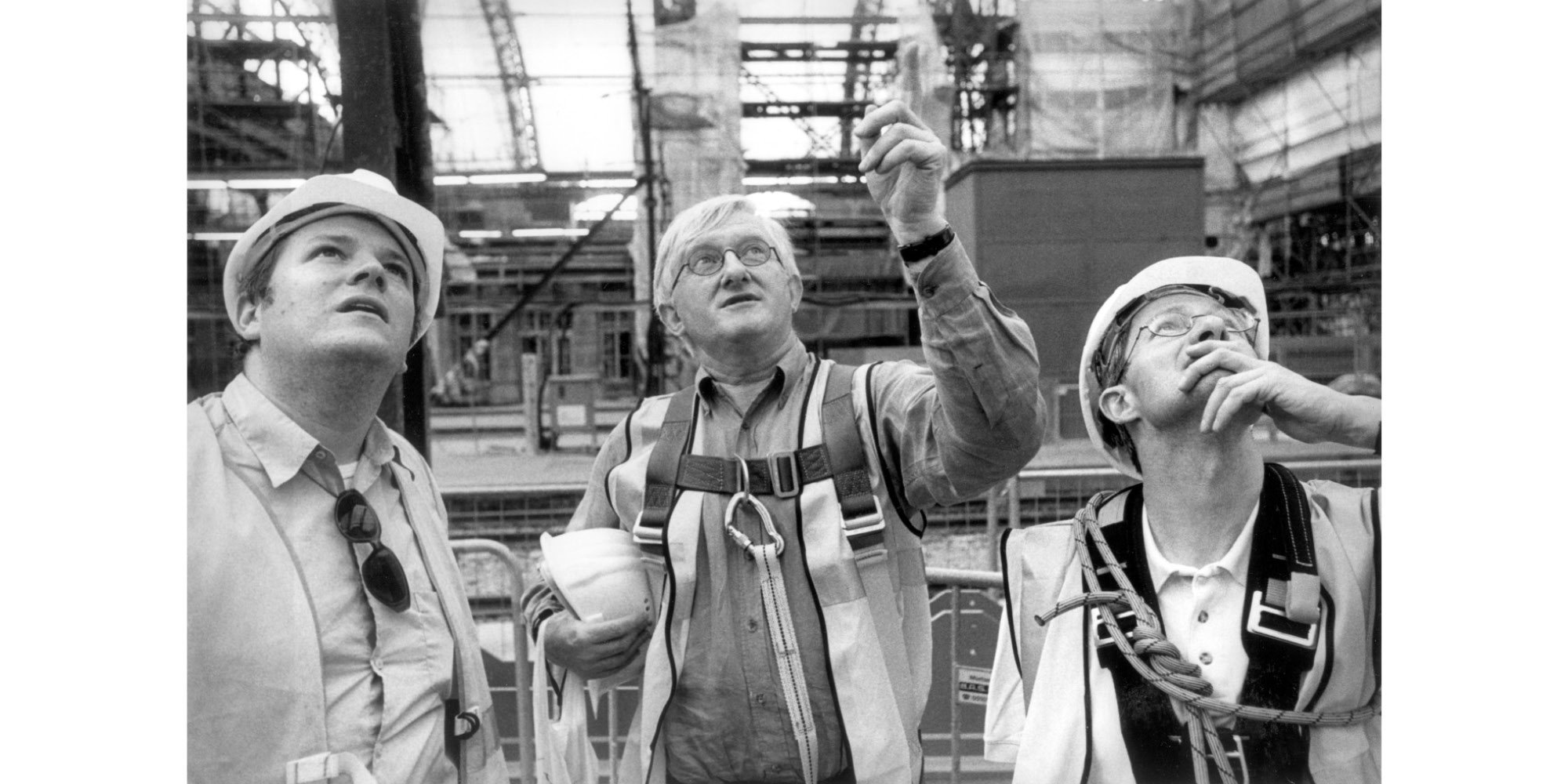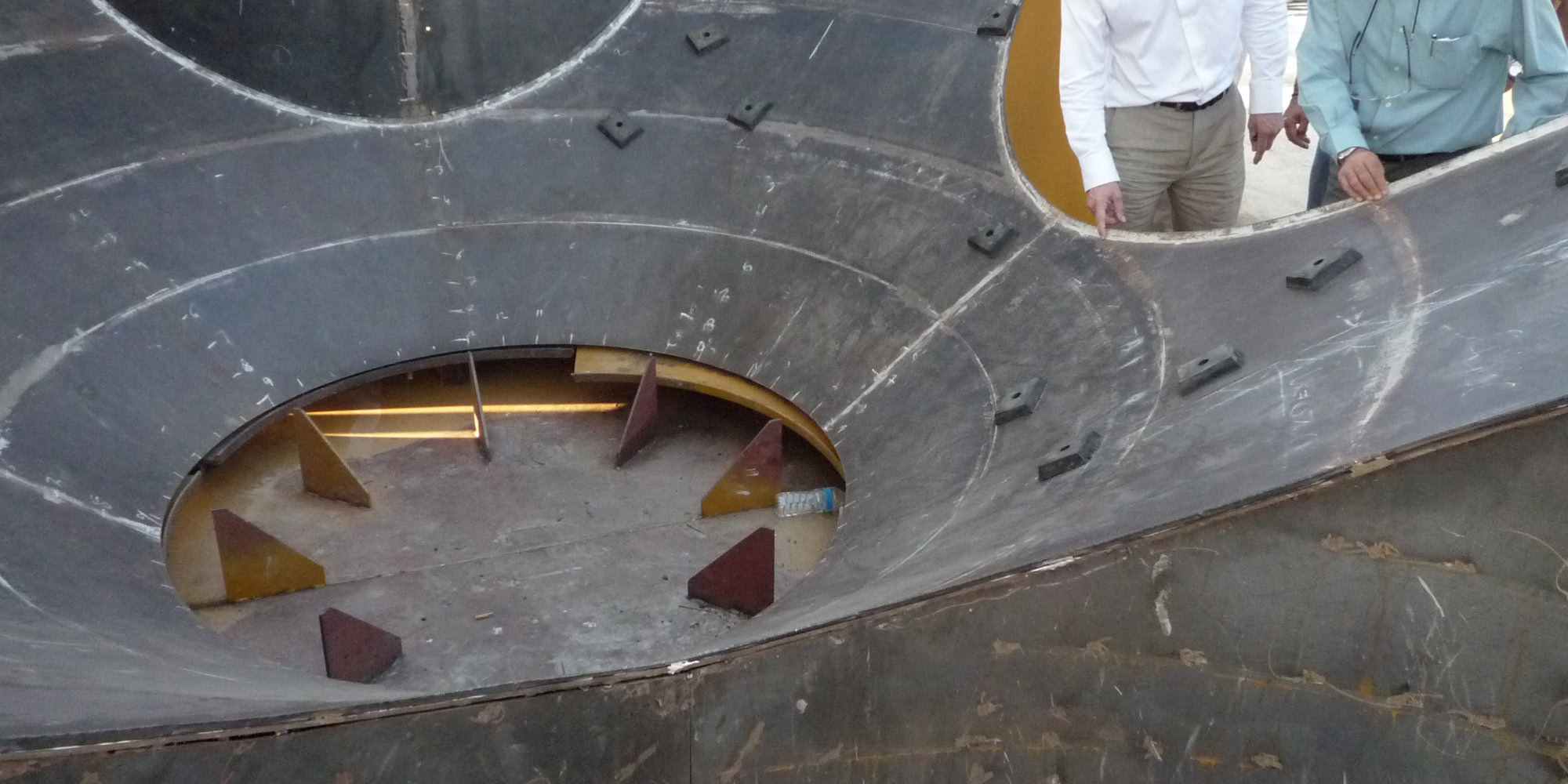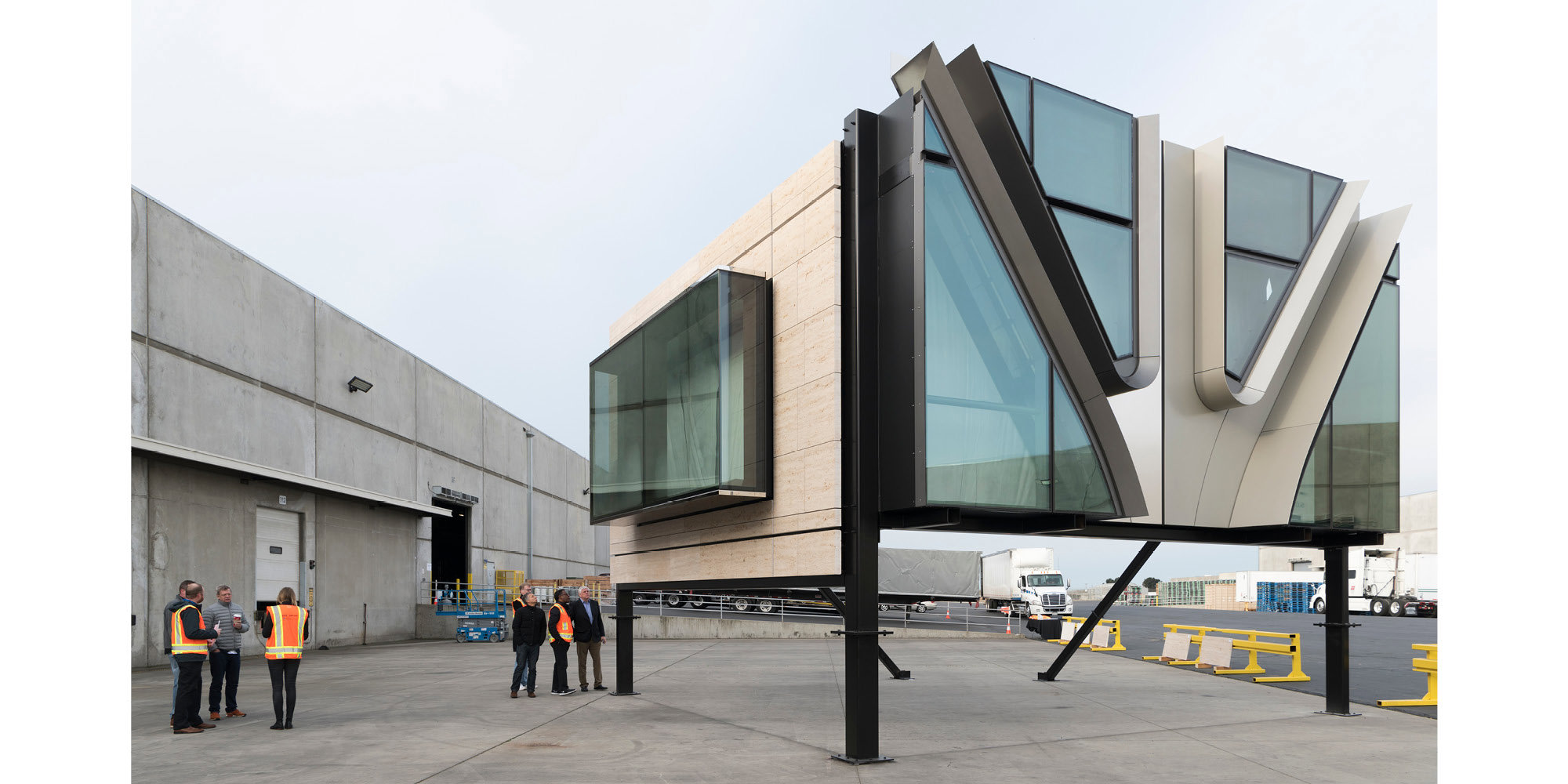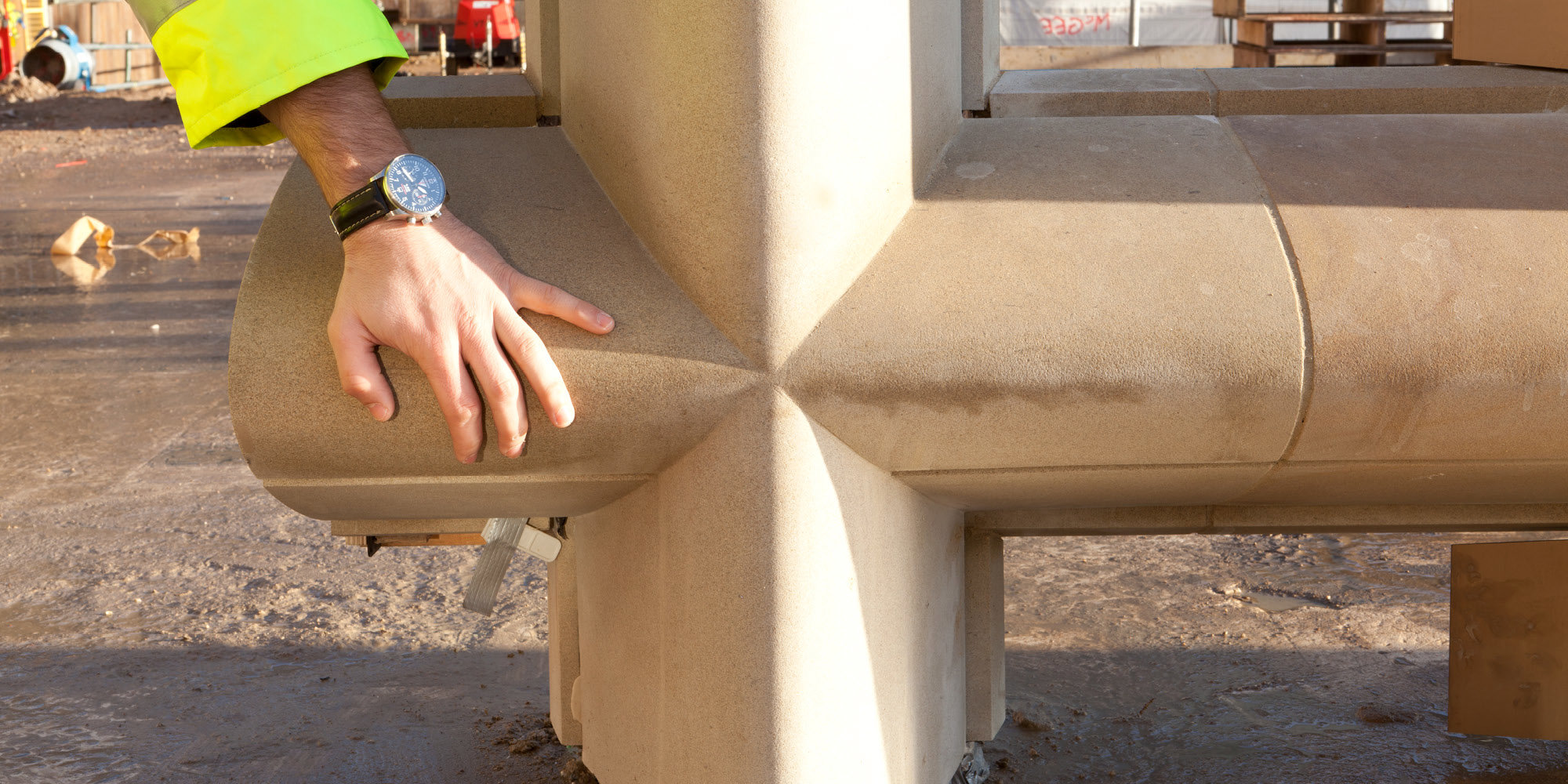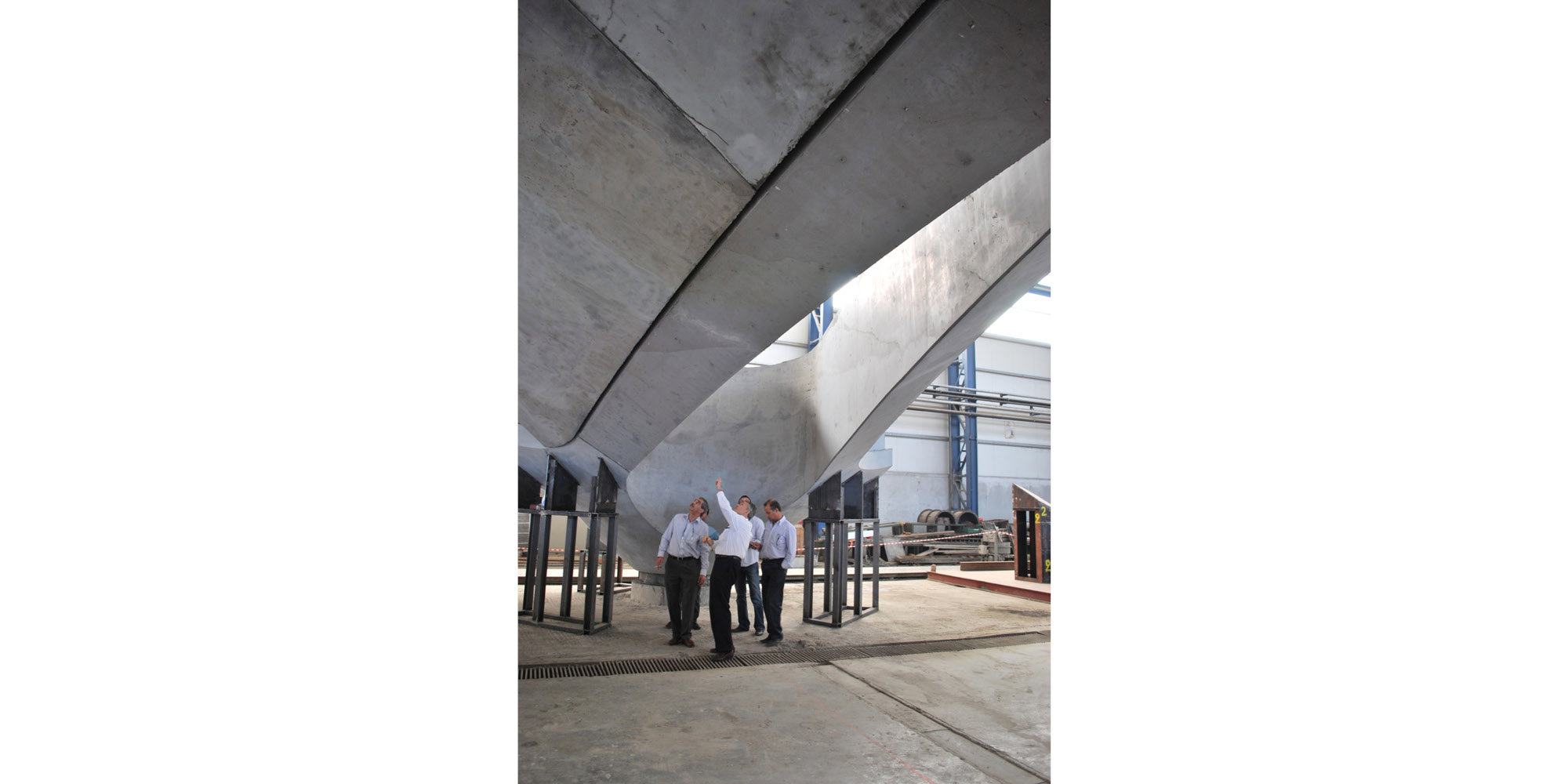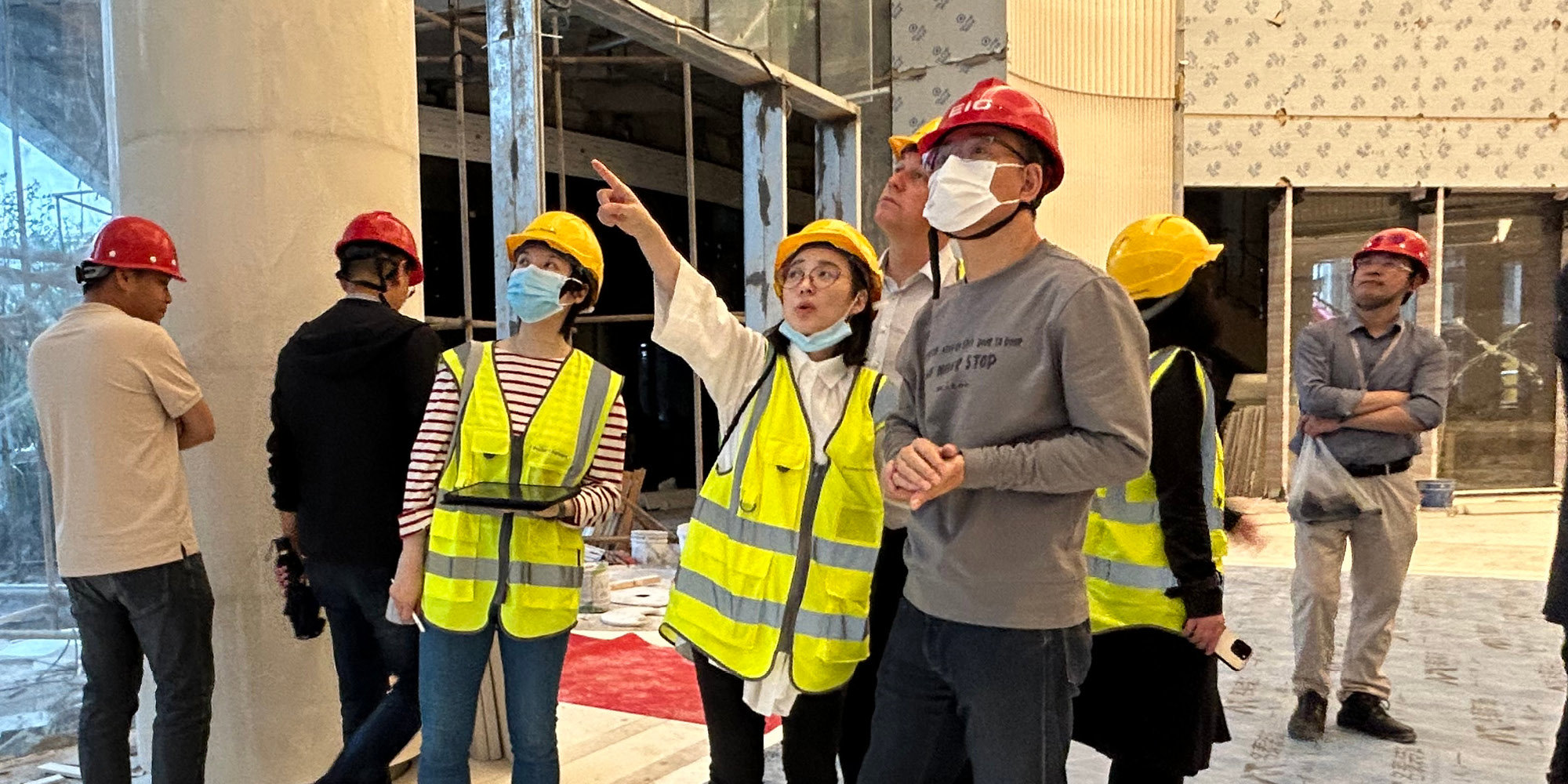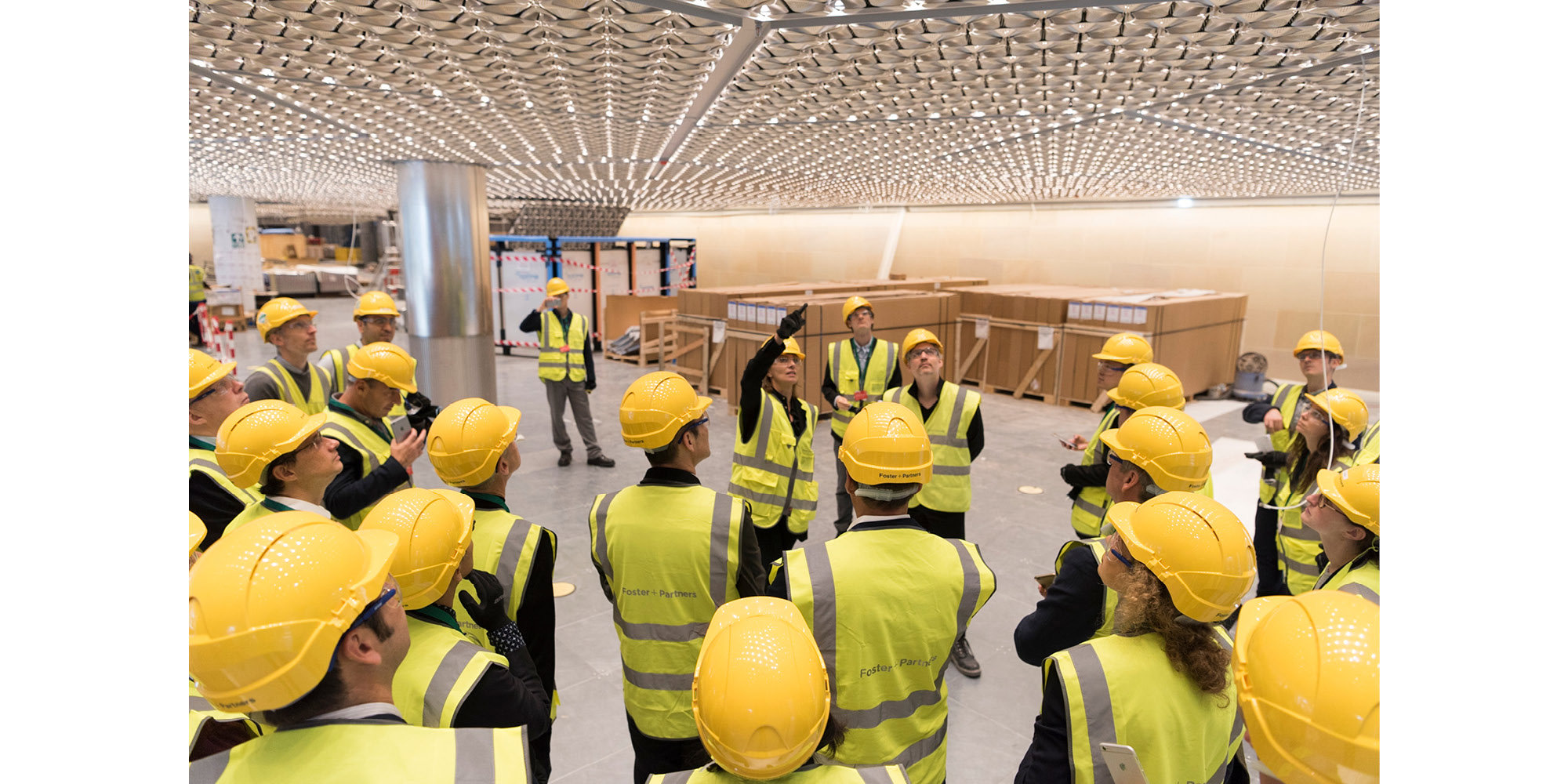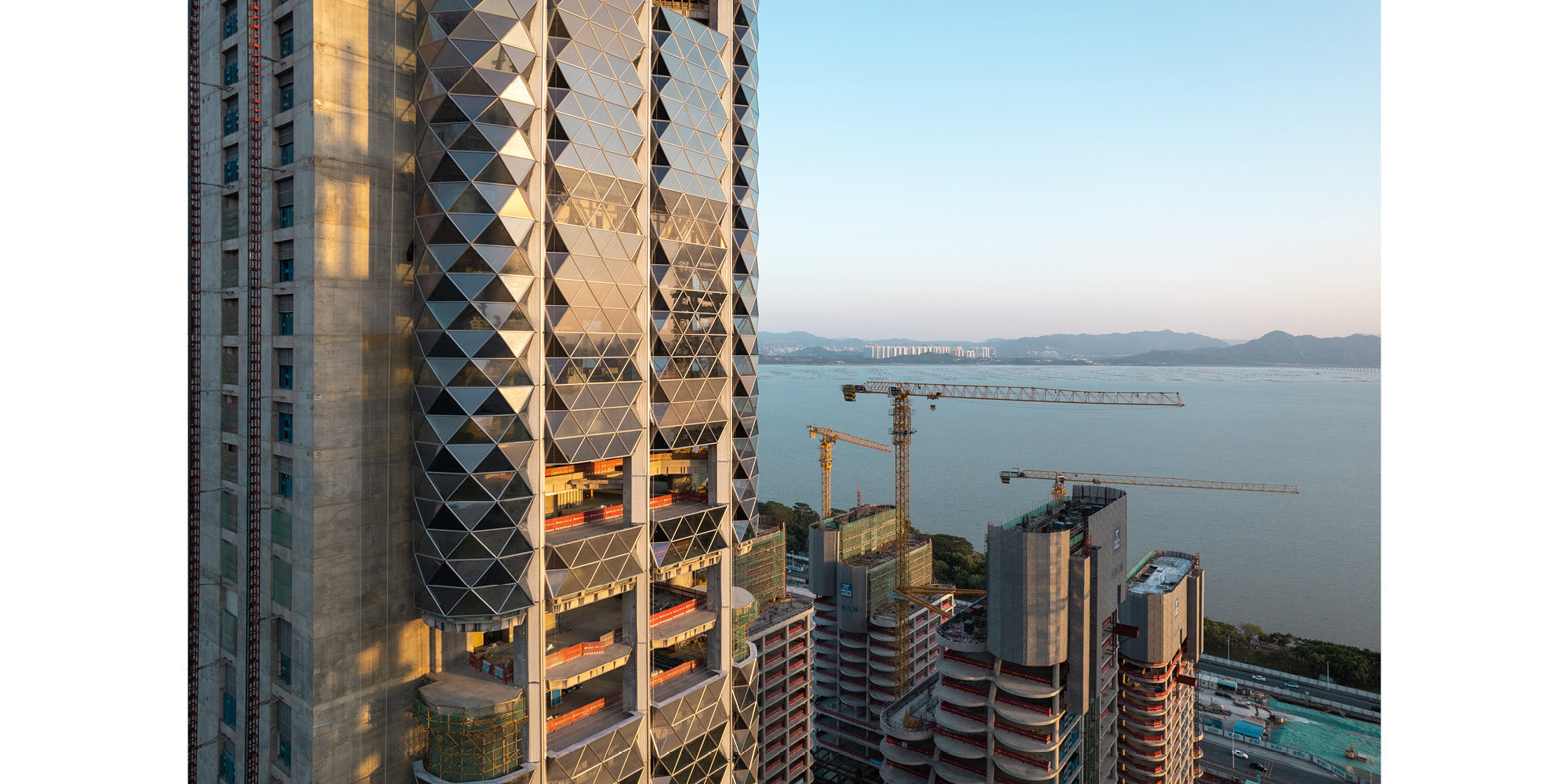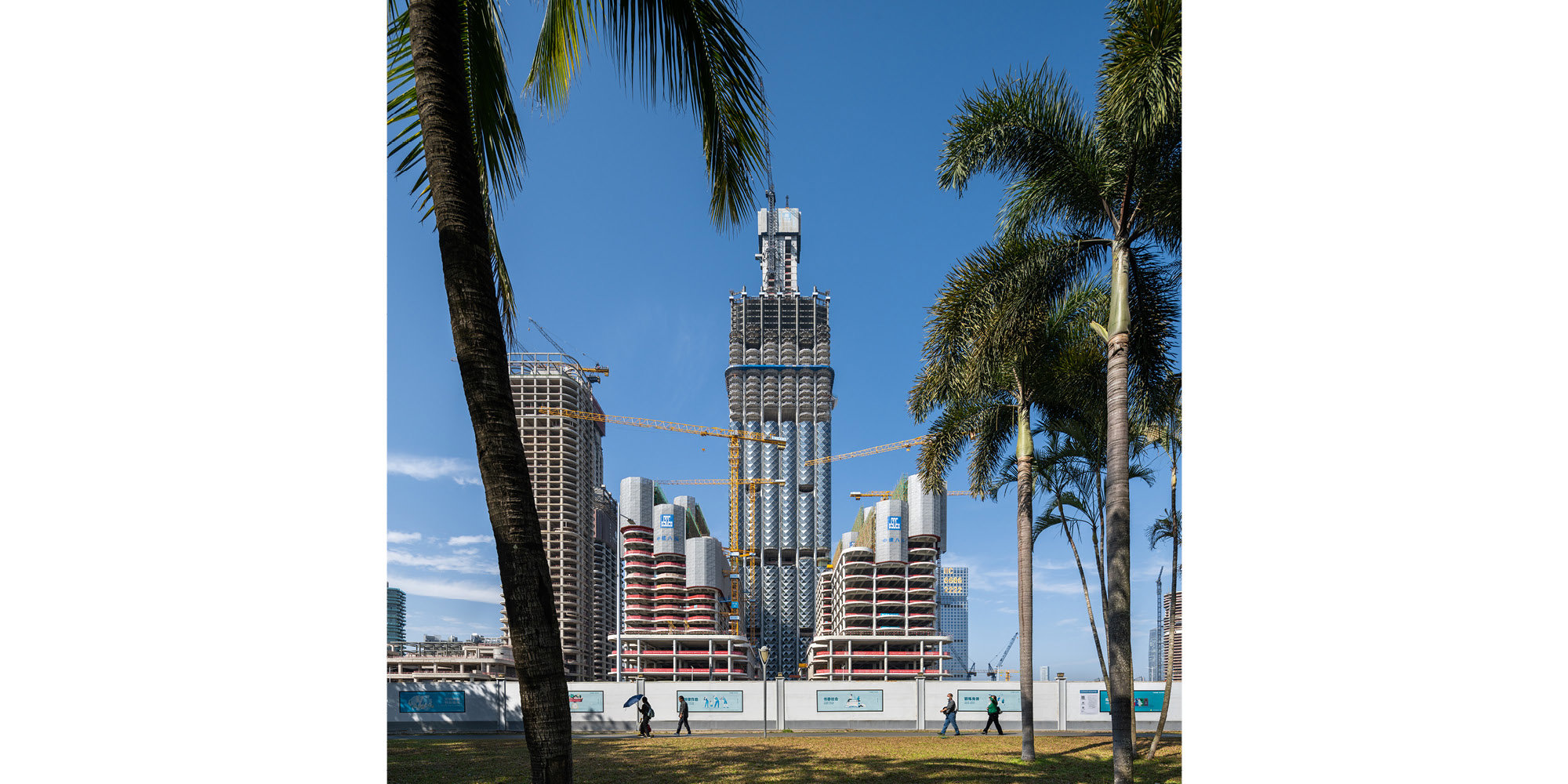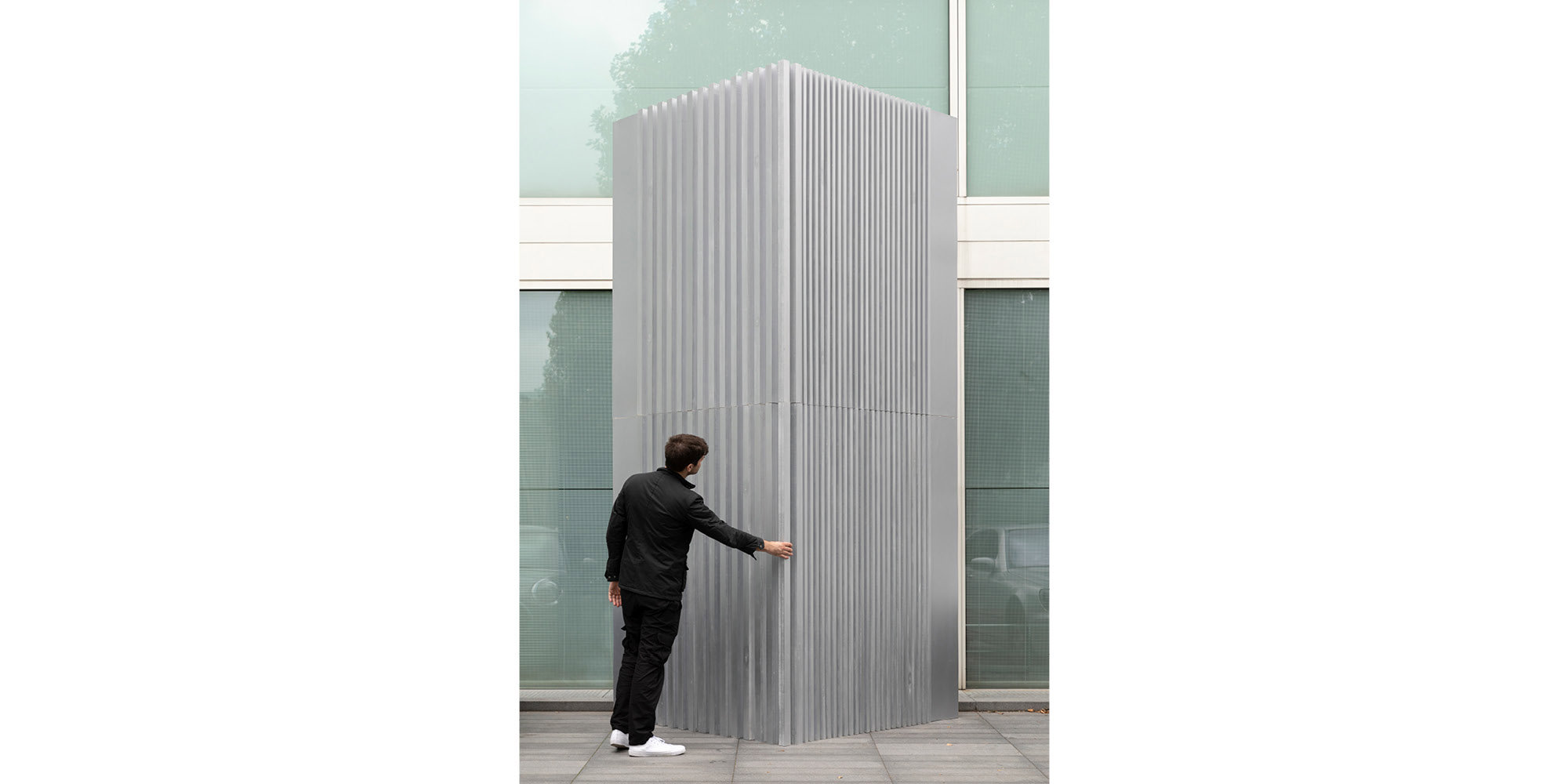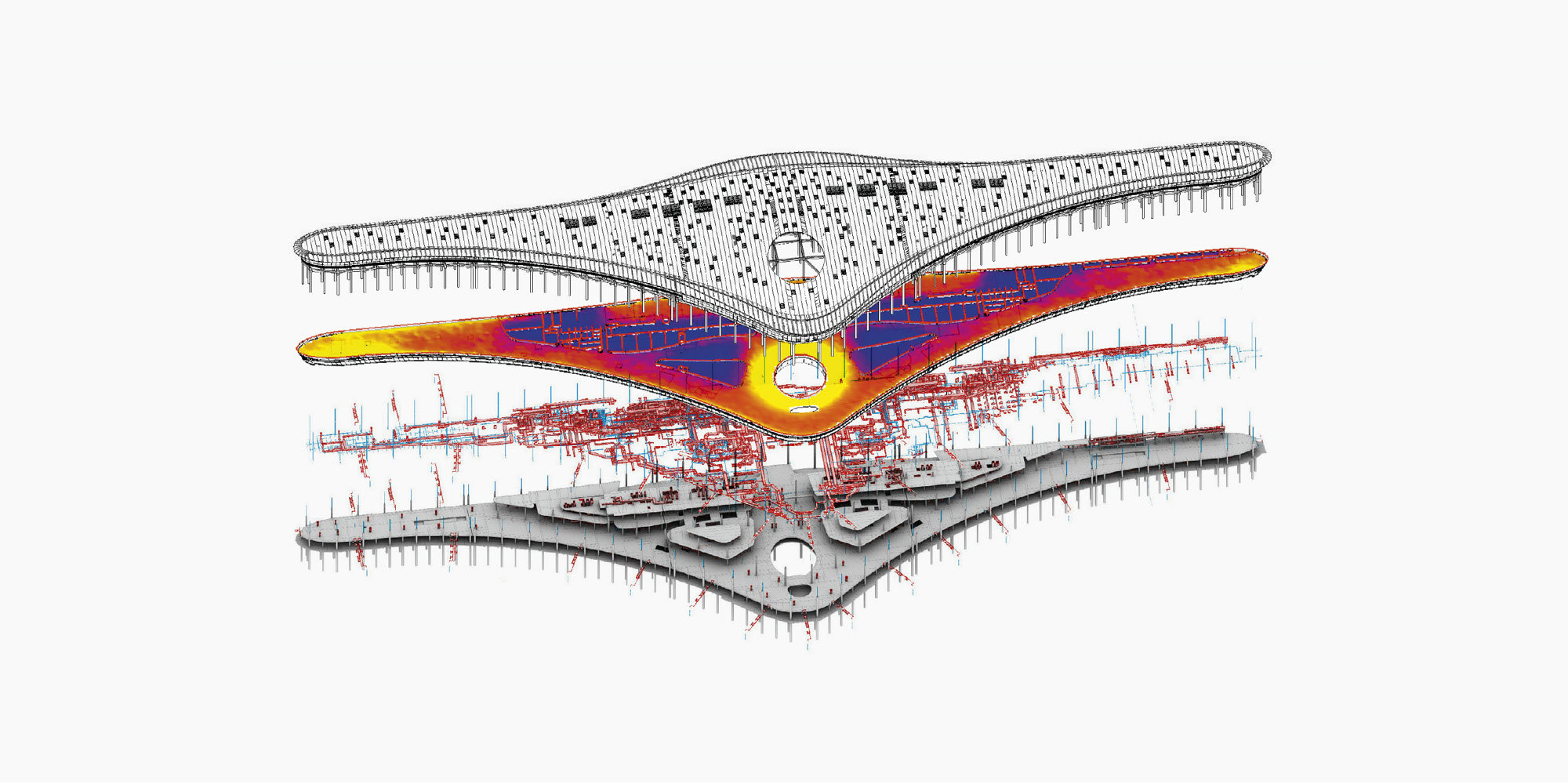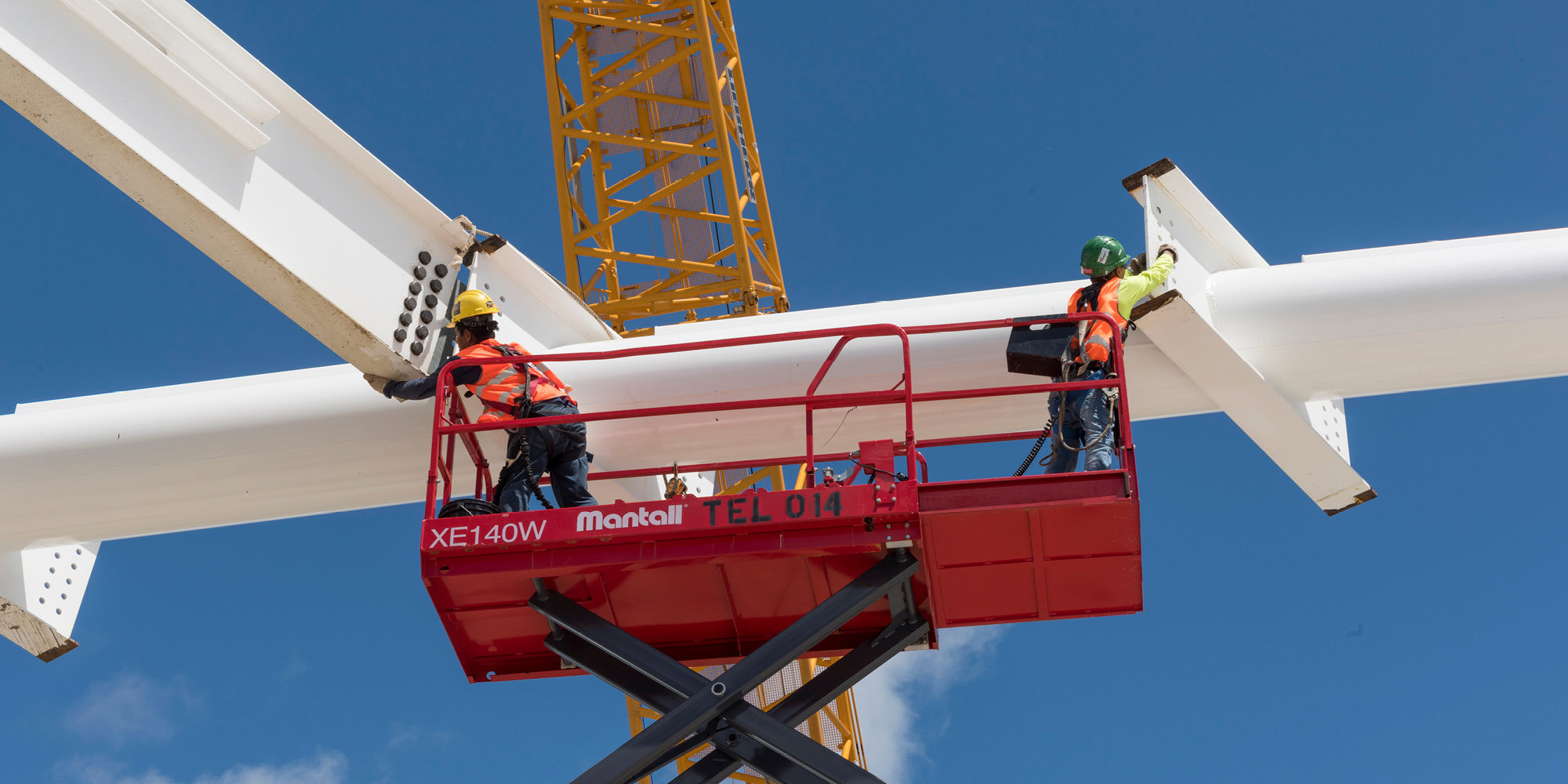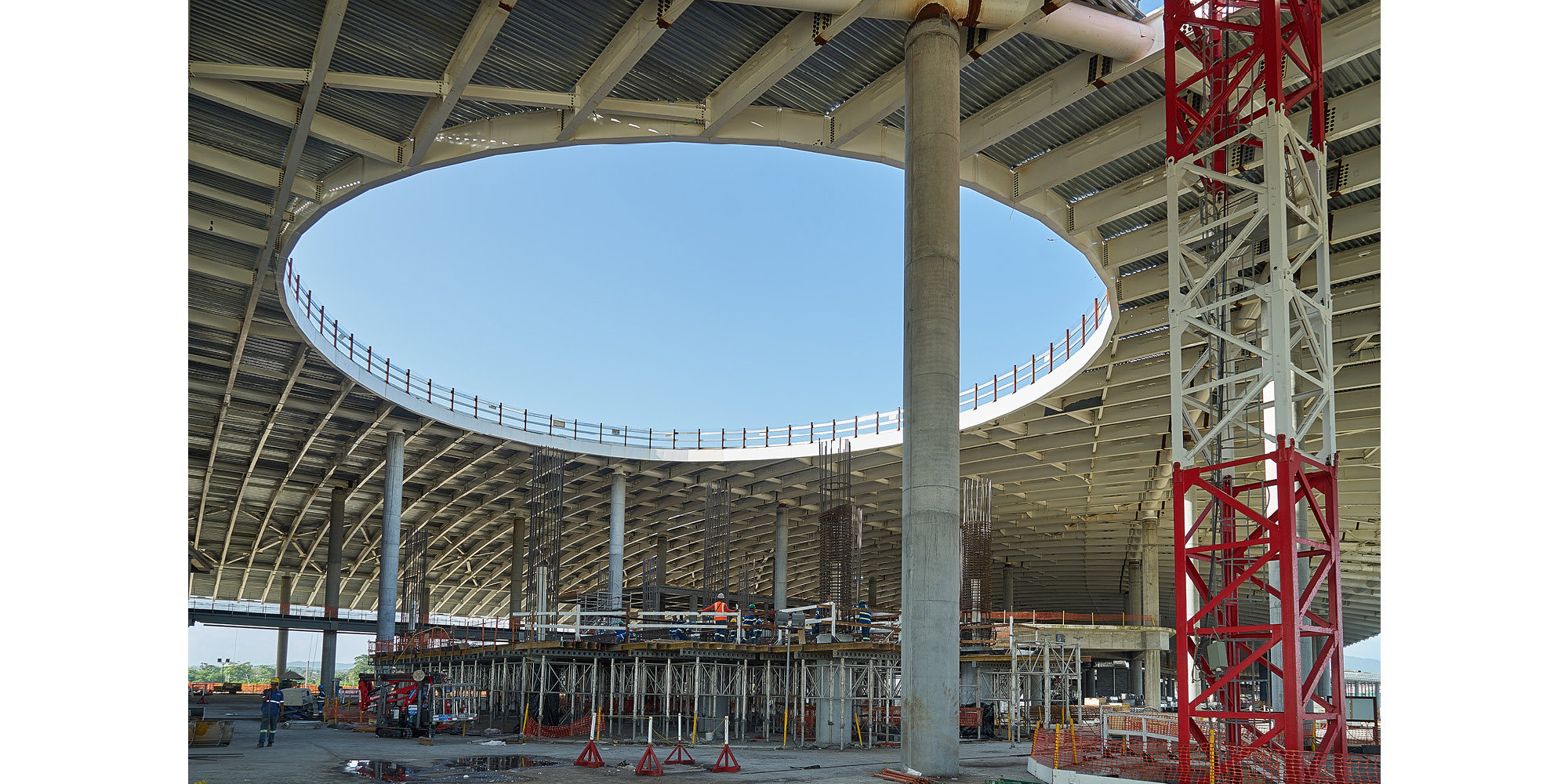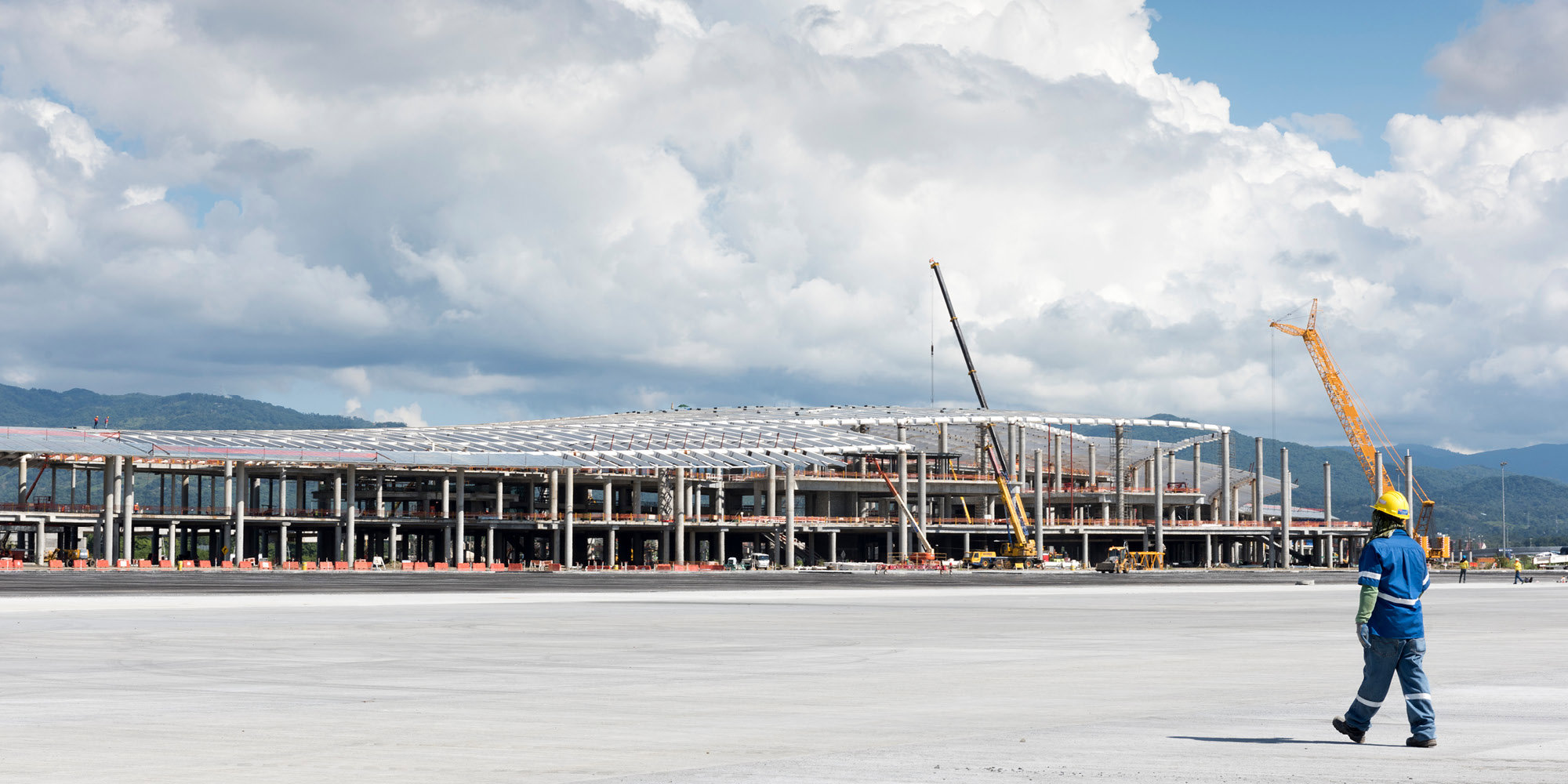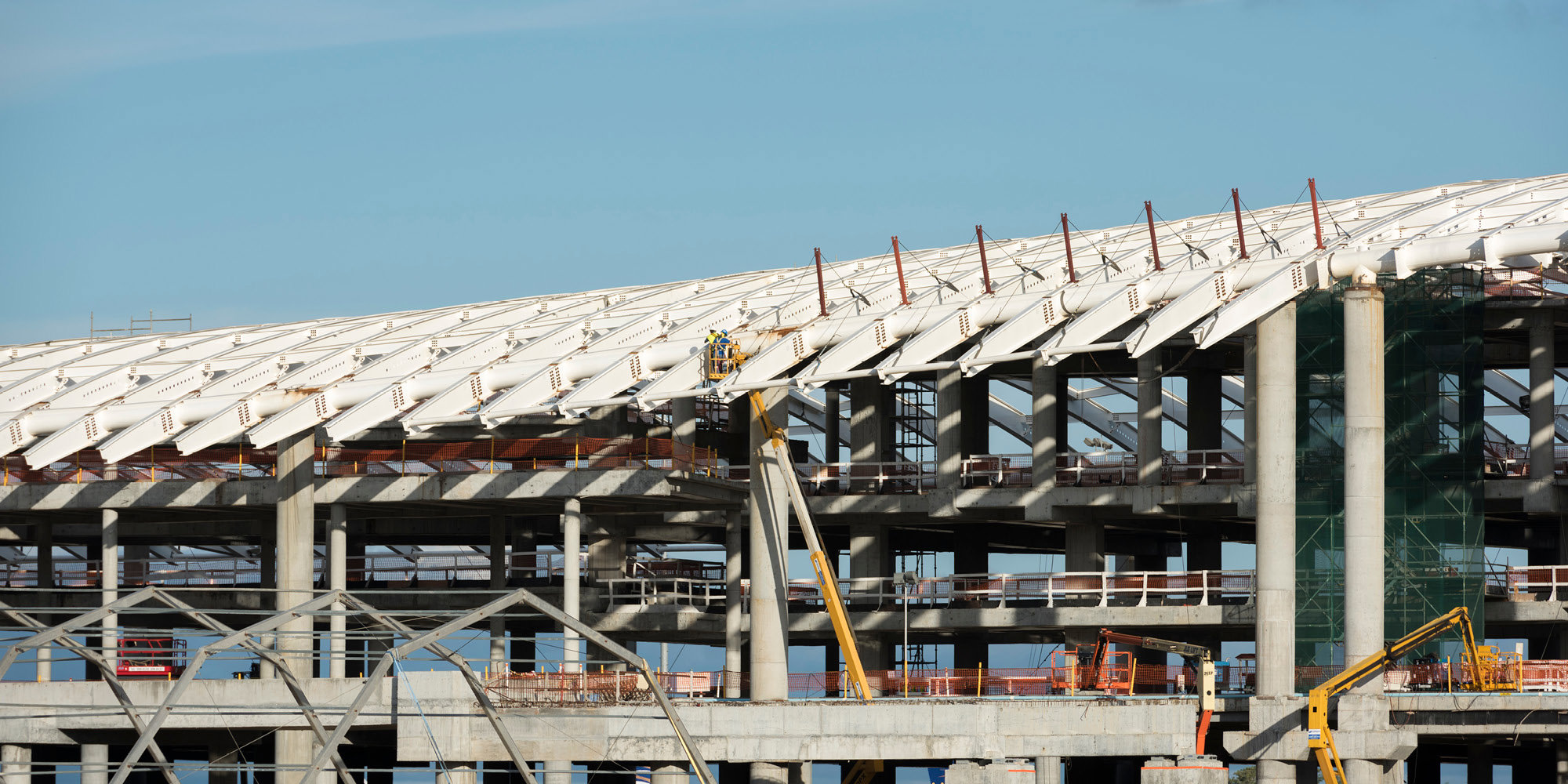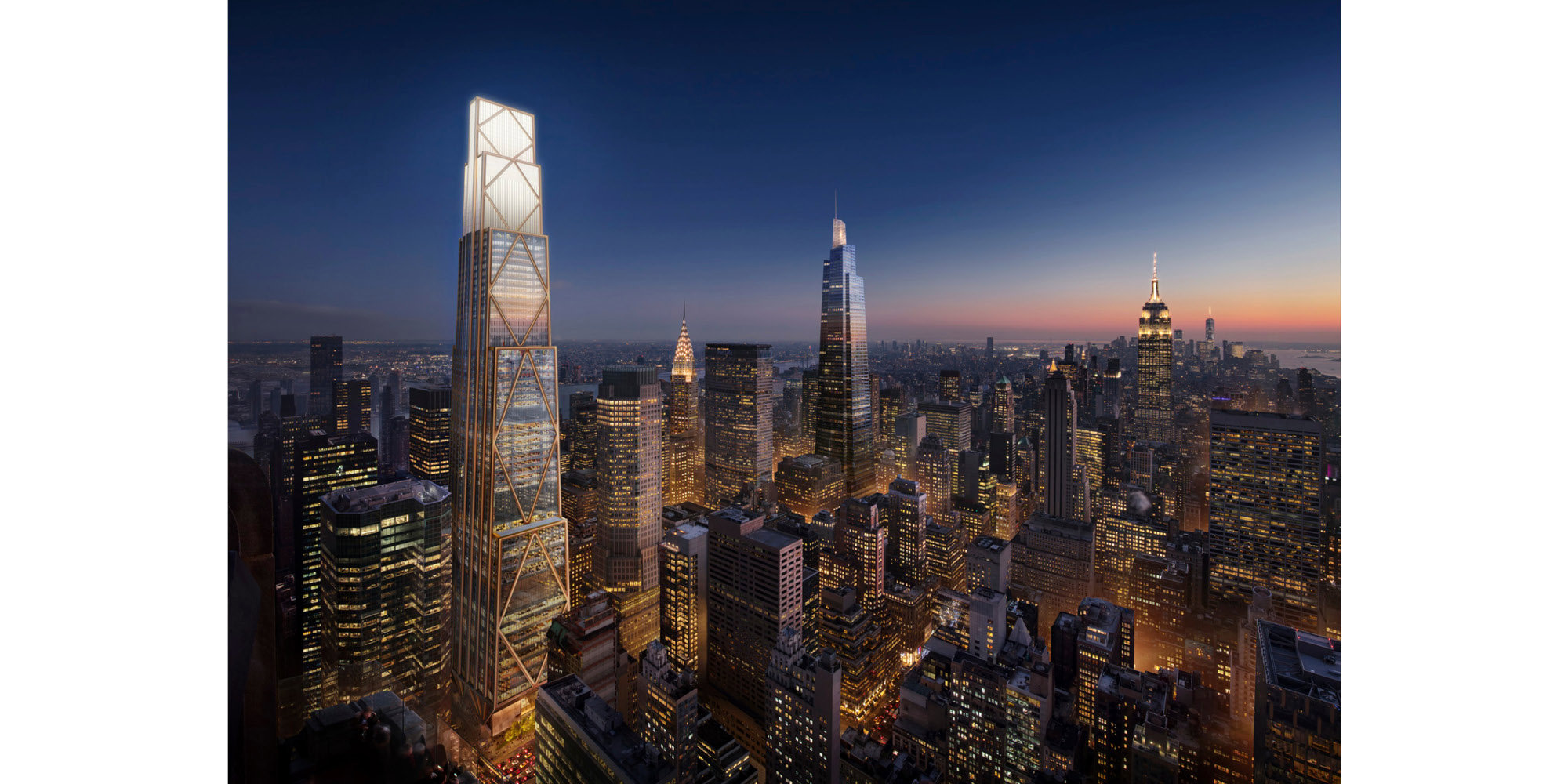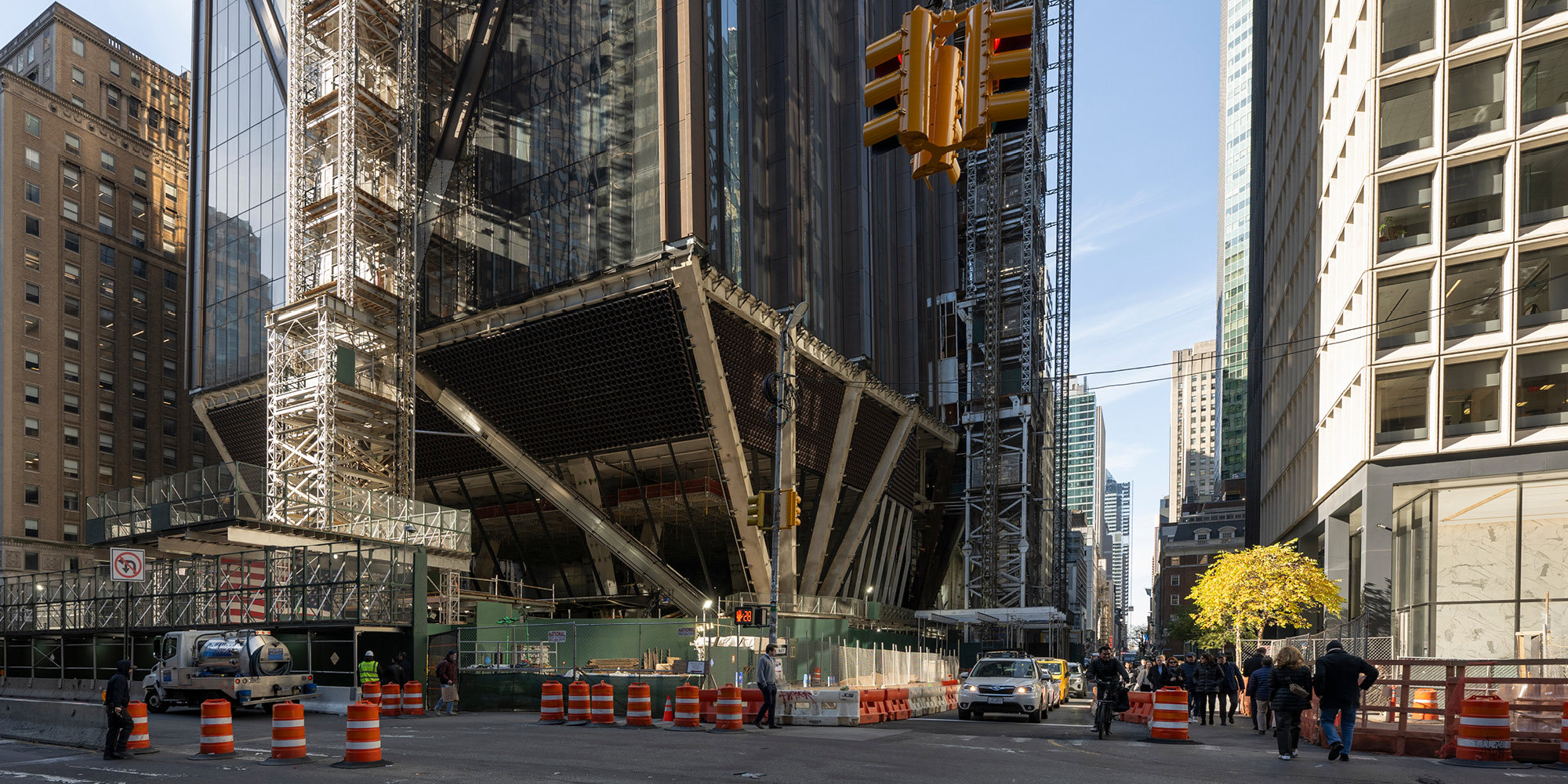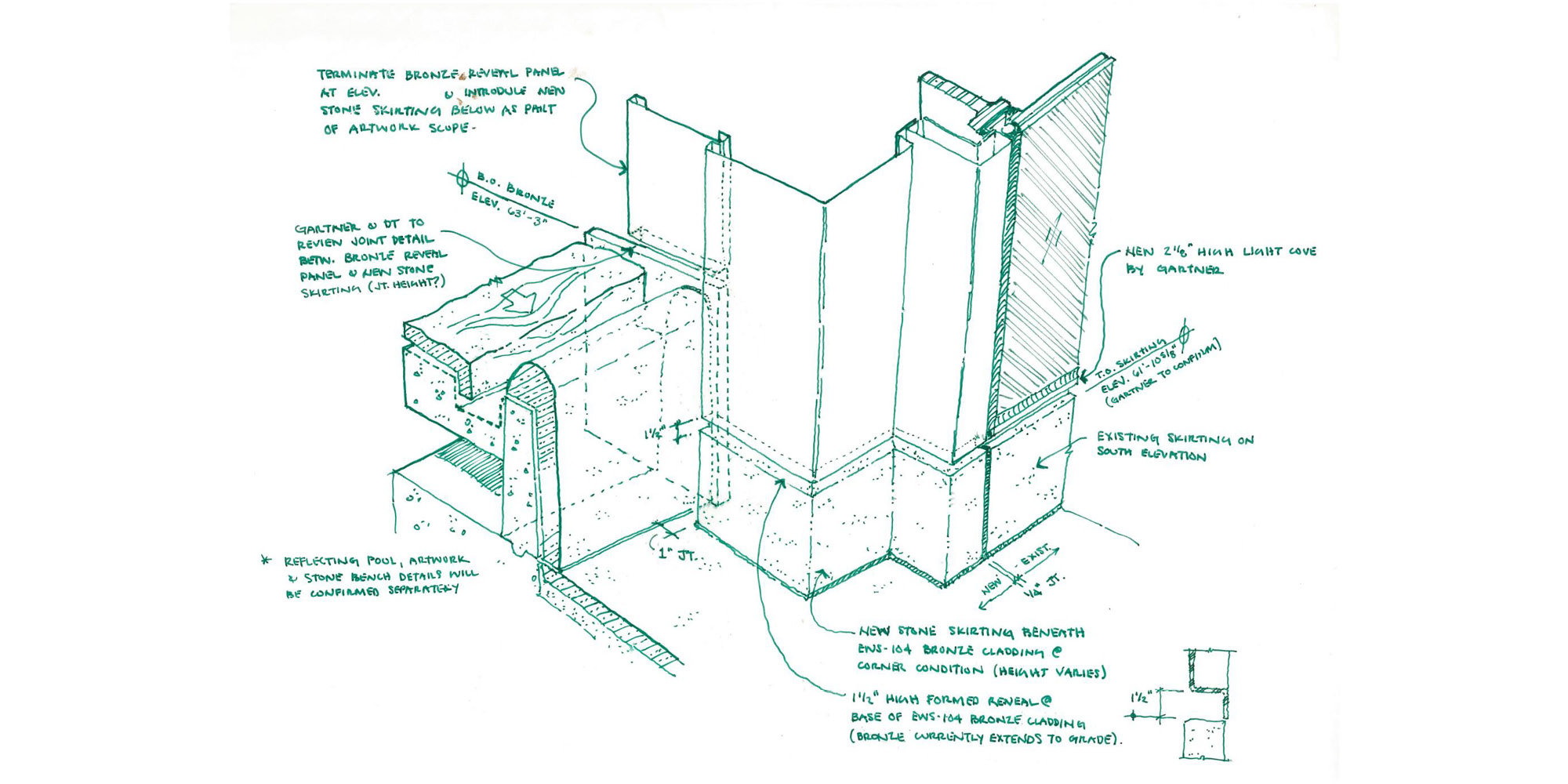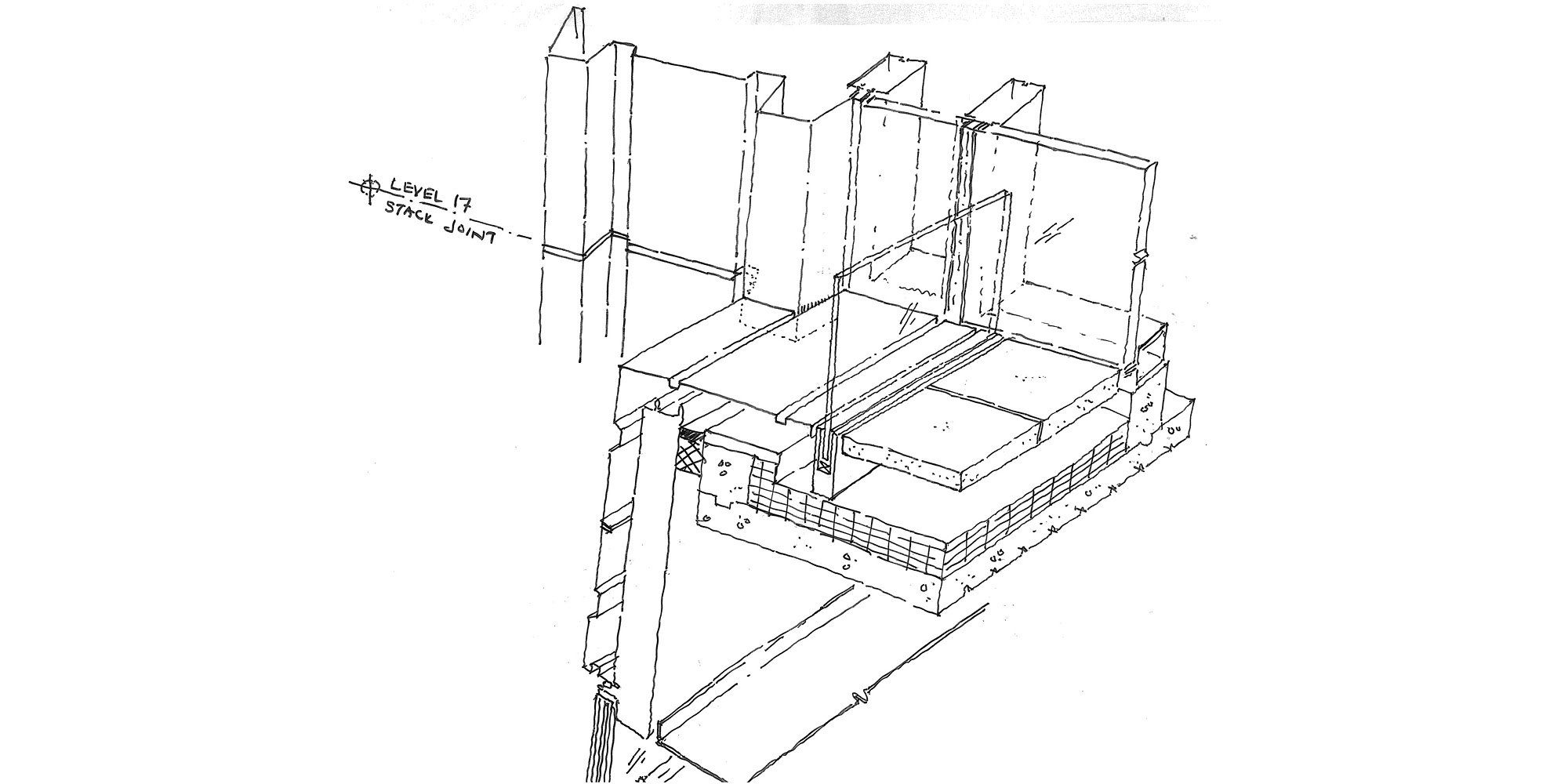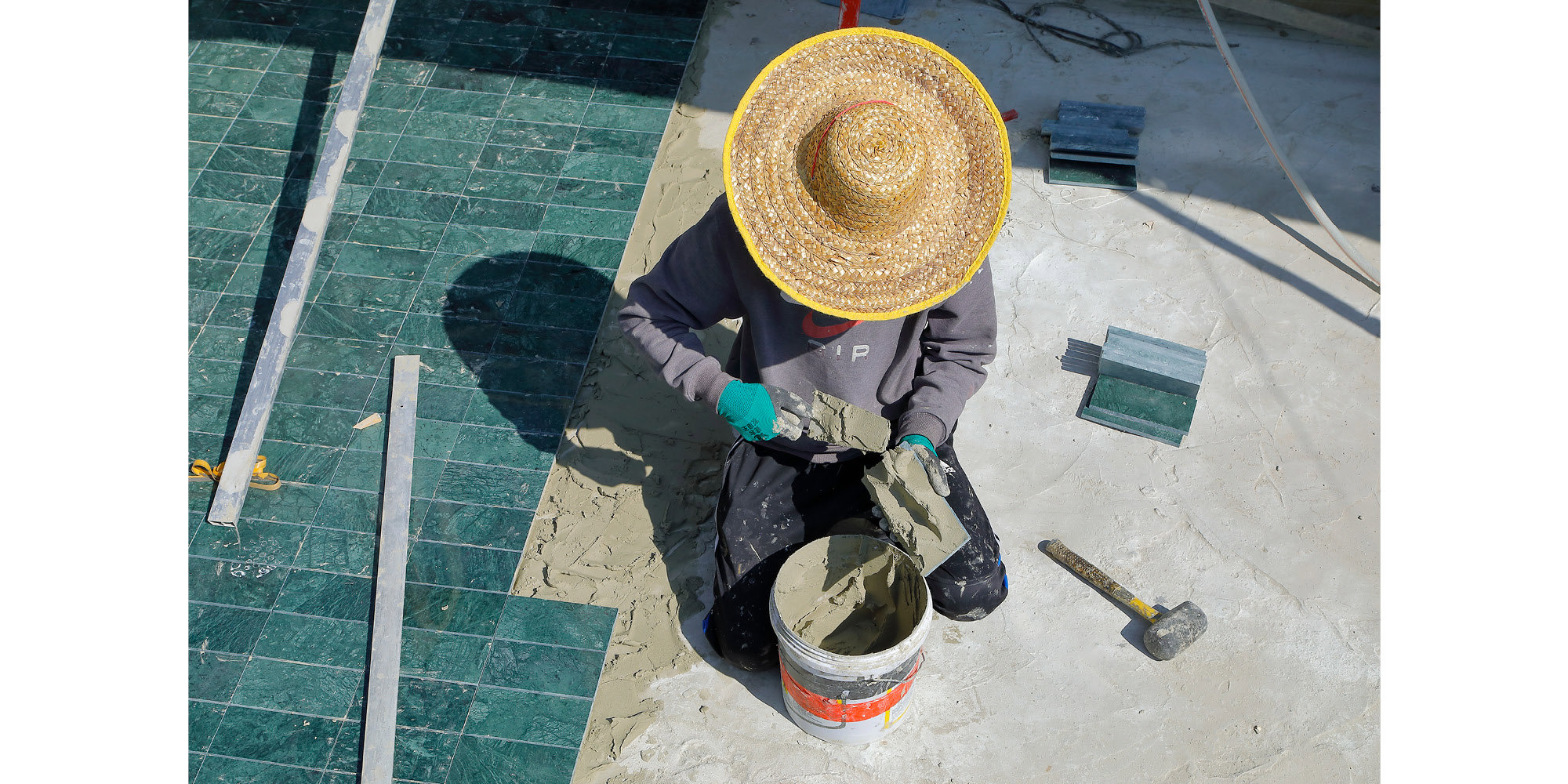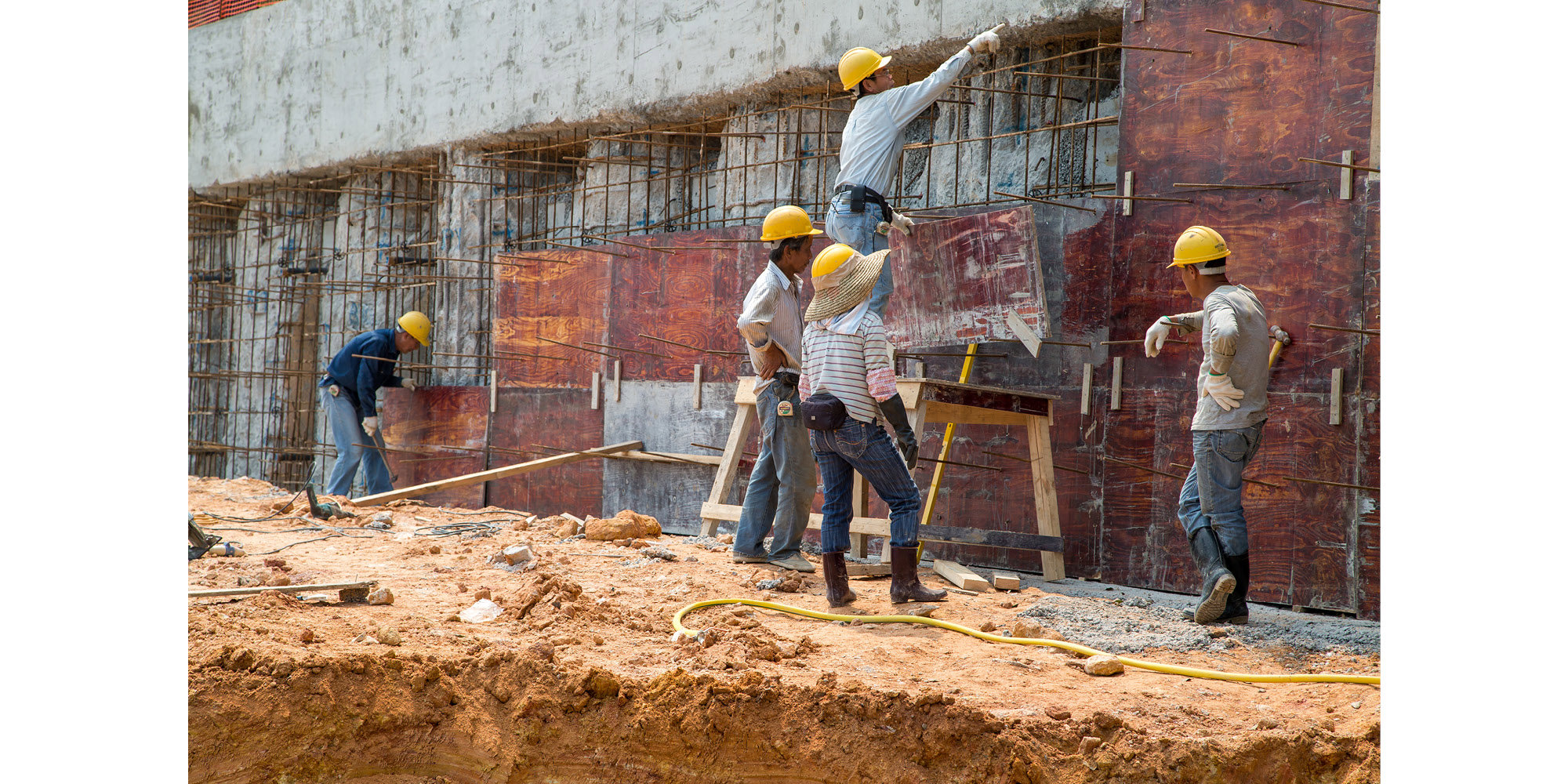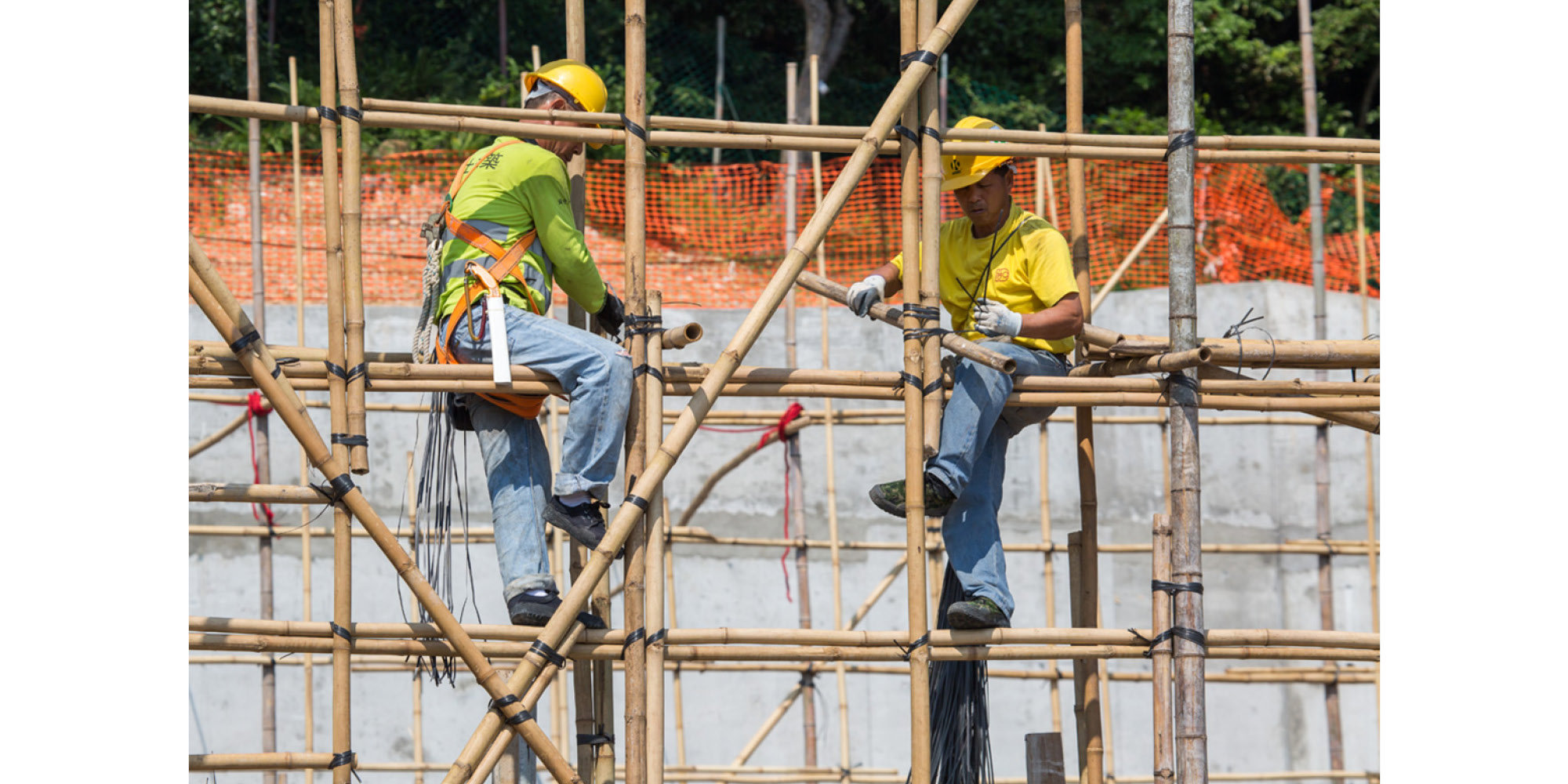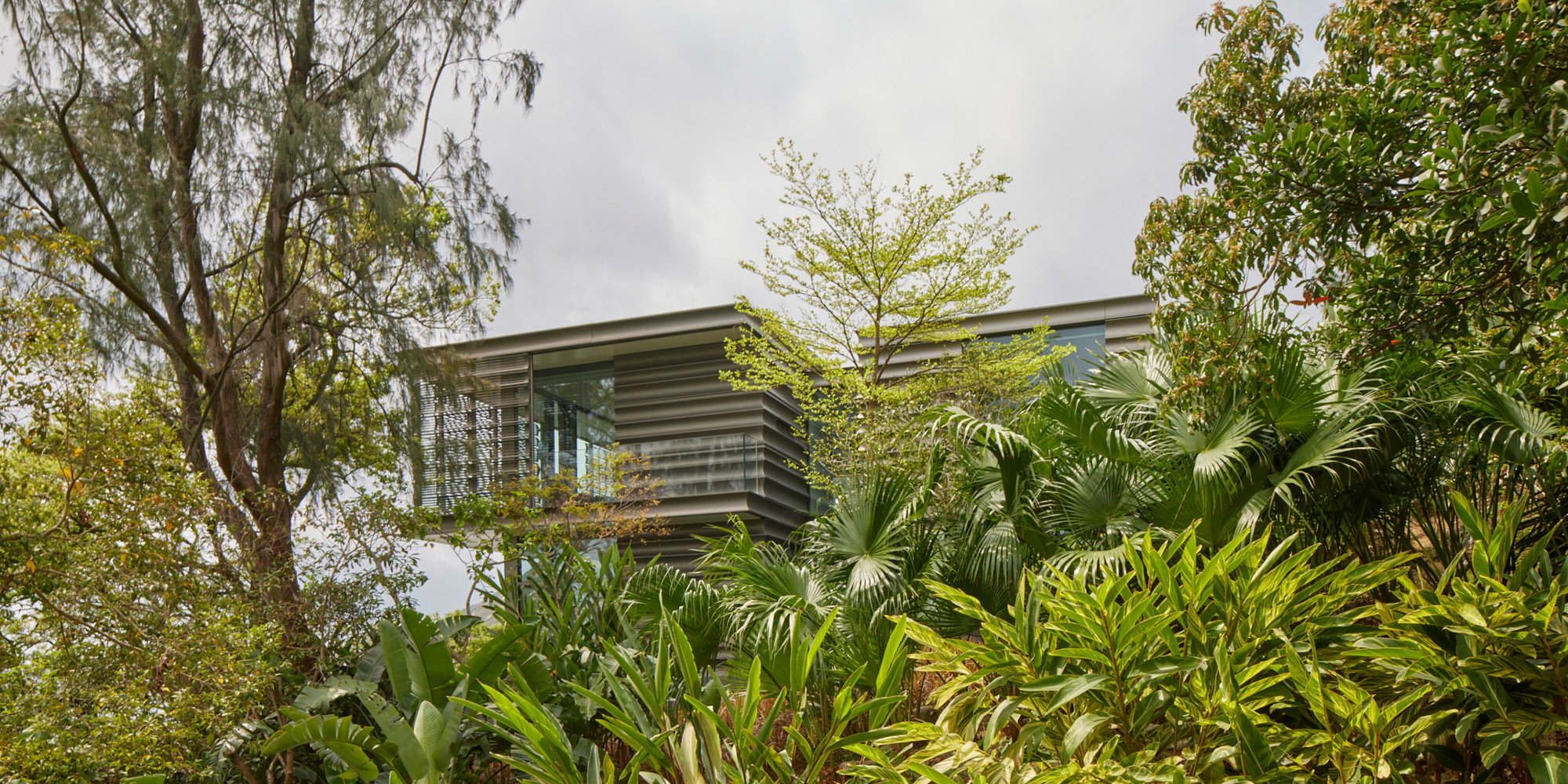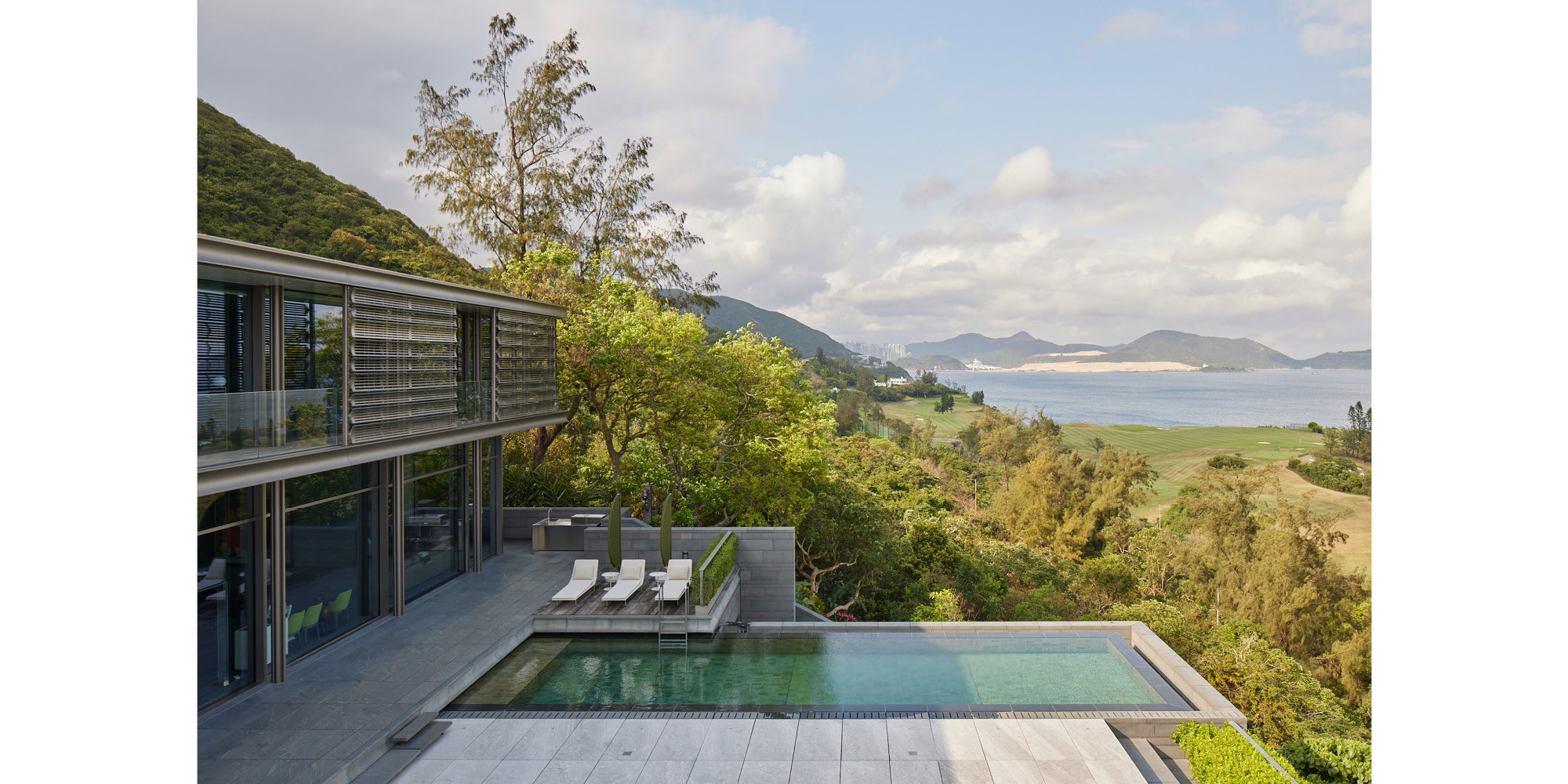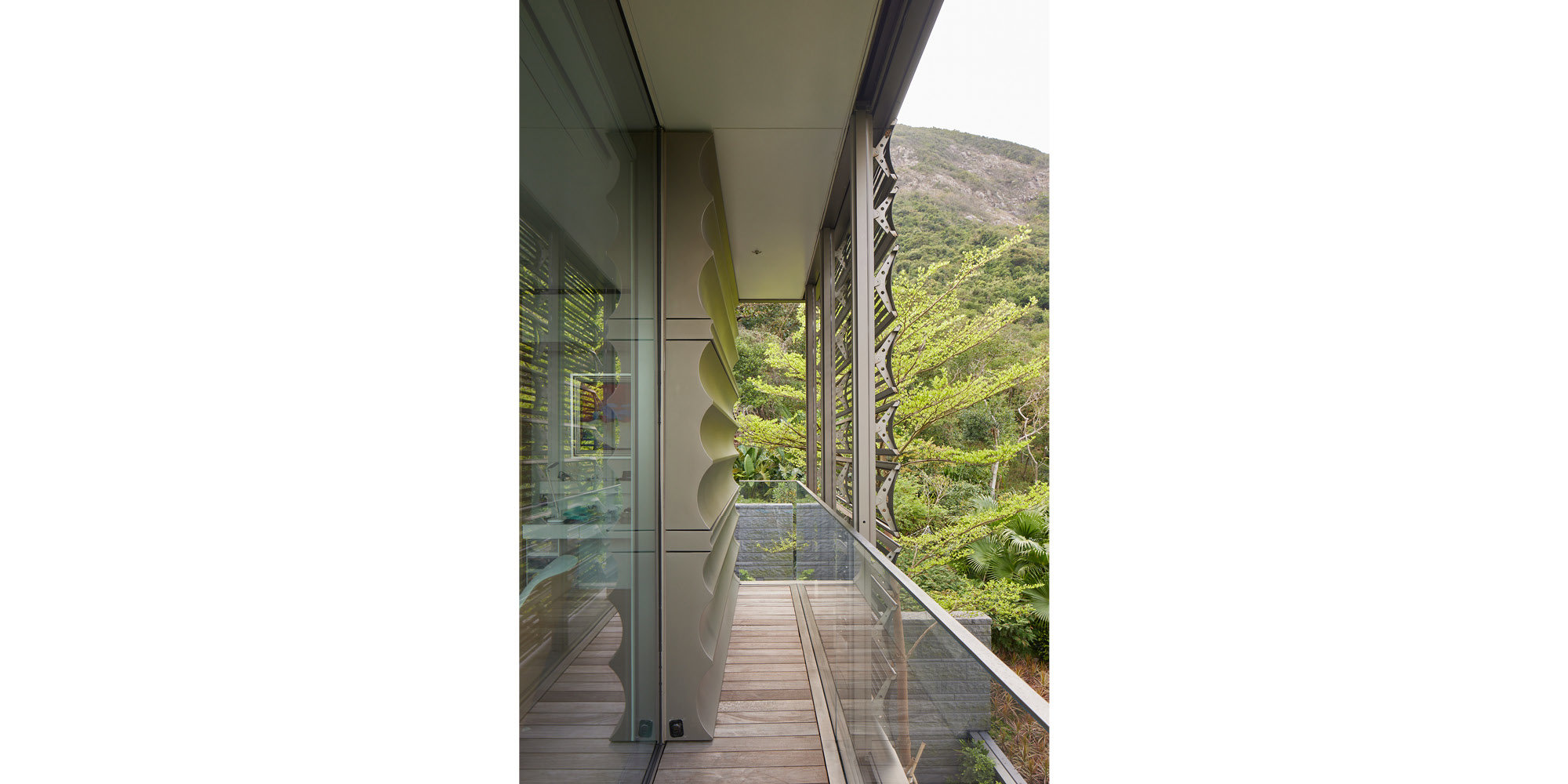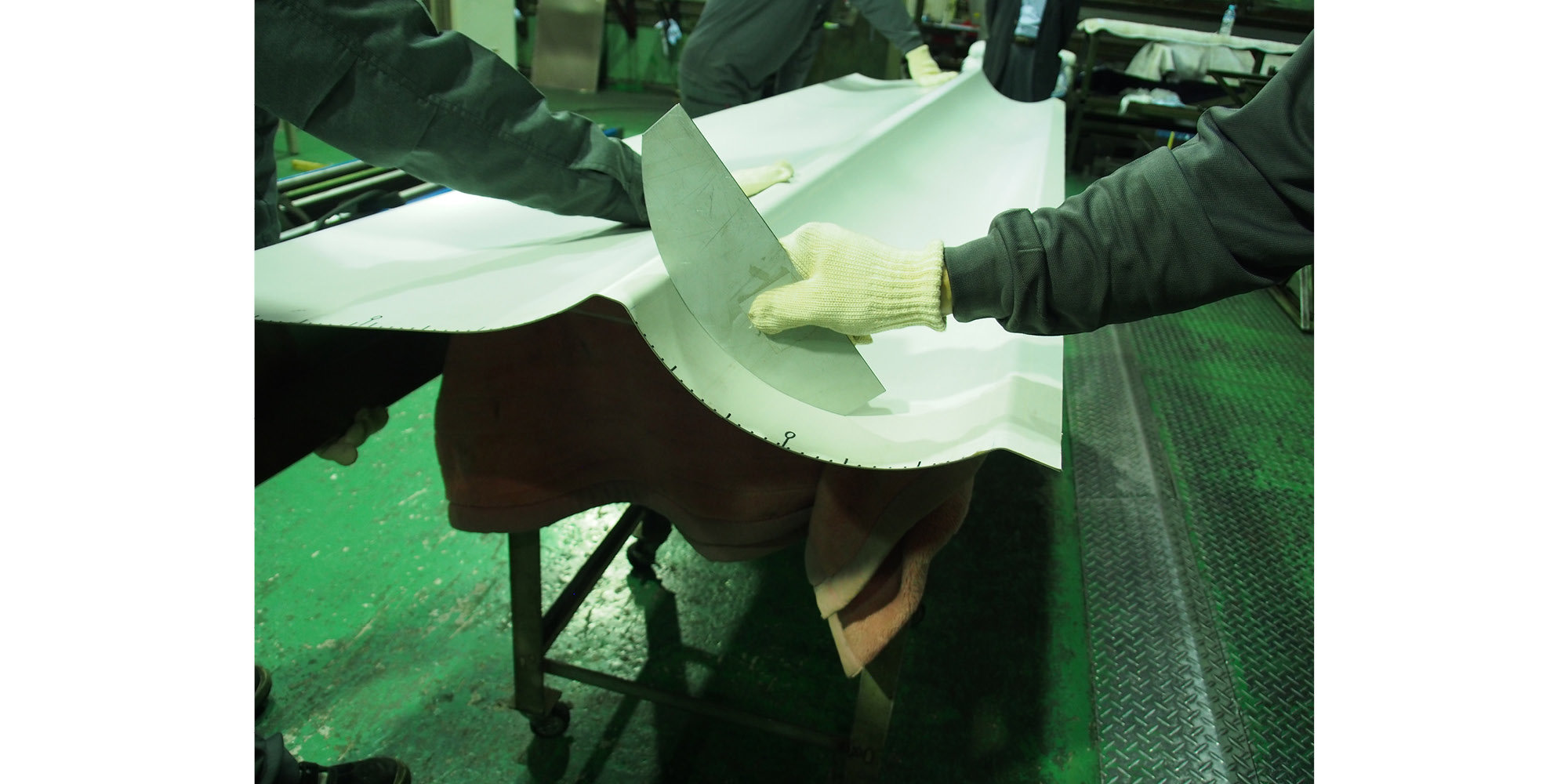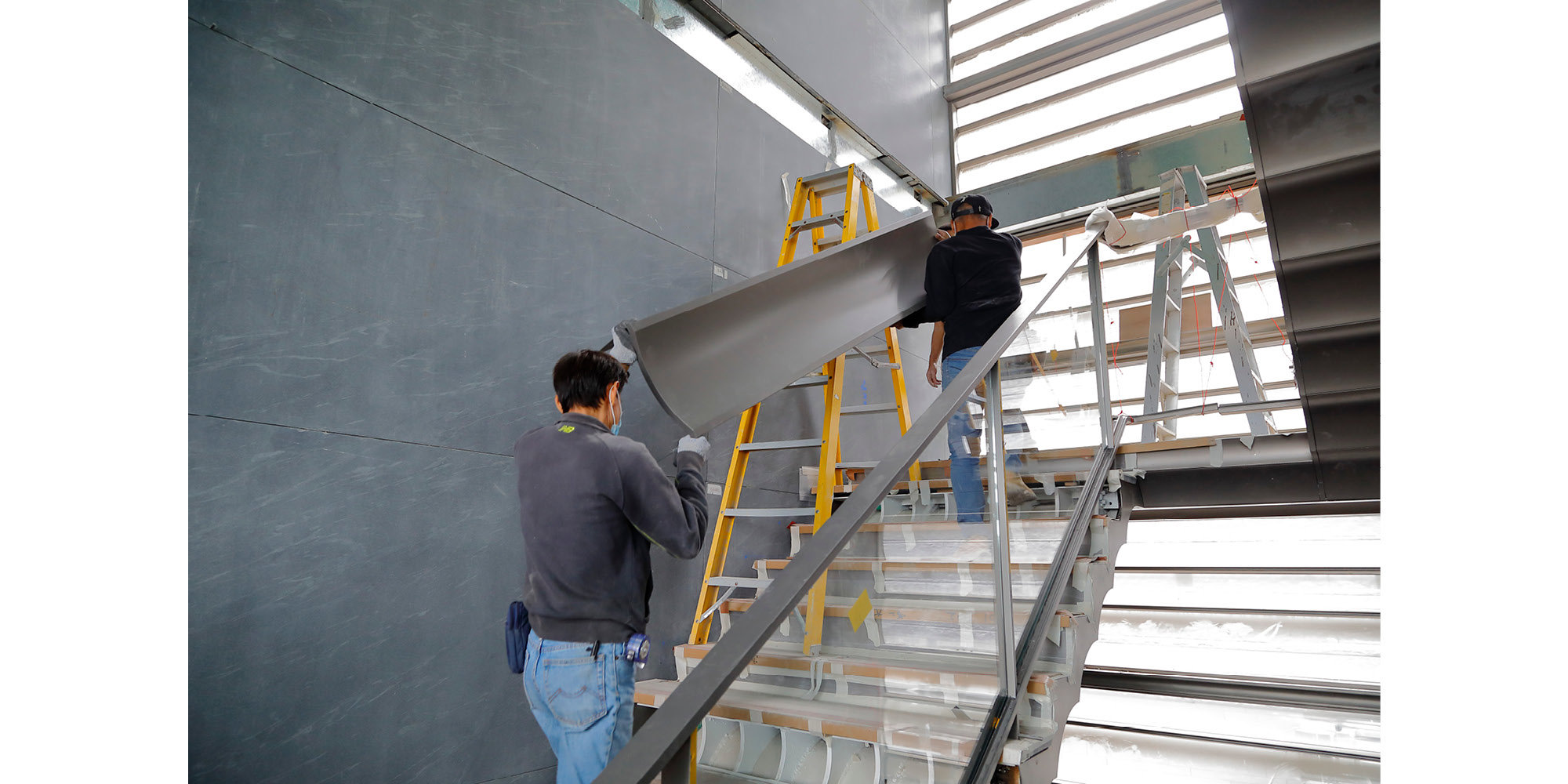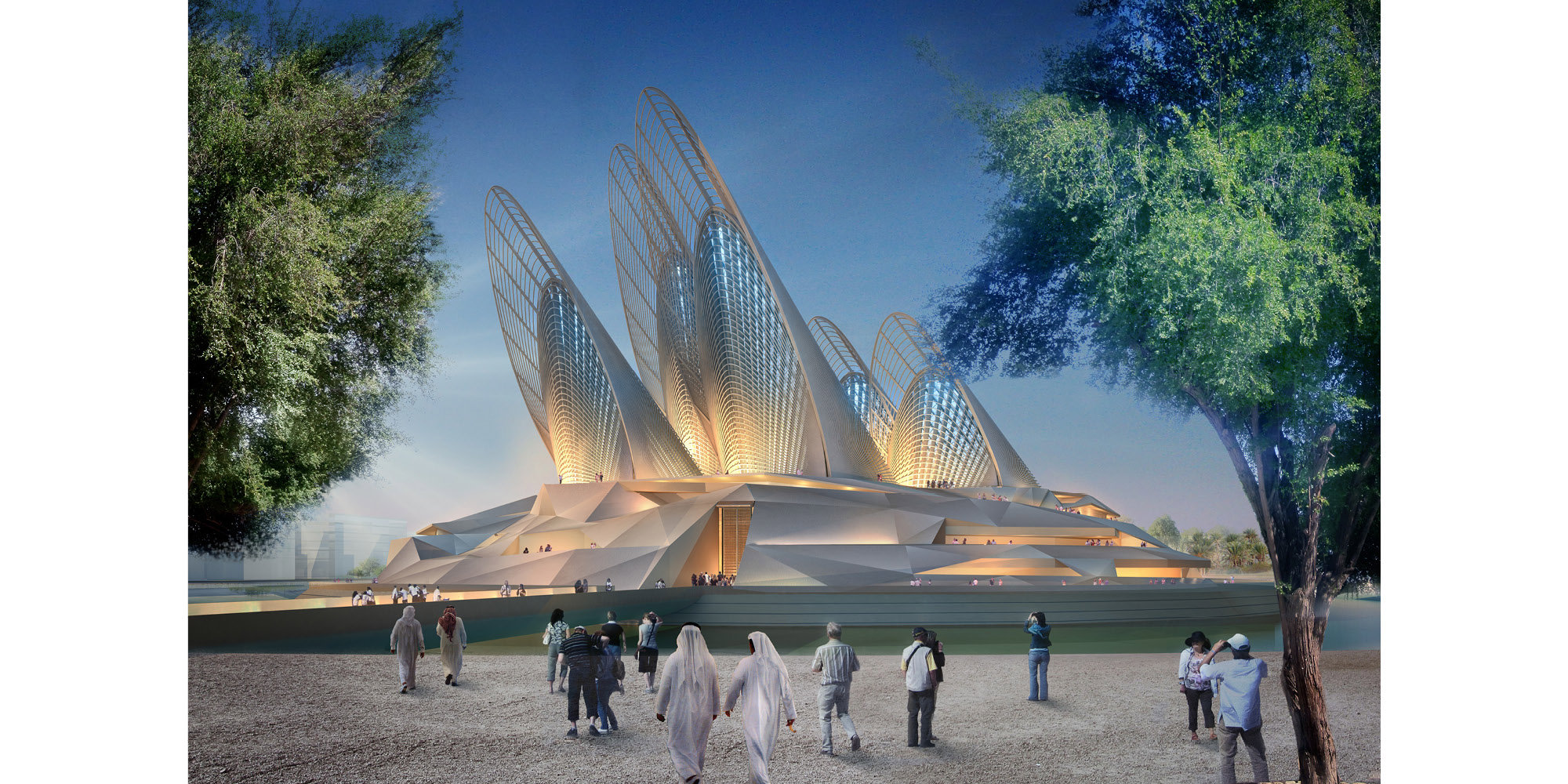As the landscape of the built environment industry is pushed towards greater fragmentation, Foster + Partners maintains a spirit of continuity, coordination and collaboration. In conversation with architects who have worked on-site across projects and regions, +Plus Journal considers the interdependence of design, engineering, and manufacture in construction, and the lessons that are learned in the act of building.
13th June 2024
Construction and the On-Site Architect
We have always worked in this integrated way that brings a wide range of skills and expertise to the design process. This makes us particularly good at translating a building from design to construction; we know how to make a design harmonious with the people who build it.
David Nelson, Senior Executive Partner and Co-Head of Design
Continuity is key
The half-century and more since the founding of Foster + Partners – then Foster Associates – by Norman and Wendy Foster, has seen an unprecedented rate of change. This has largely been technology driven, profoundly affecting every aspect of our lives, and the architecture and the construction industries are no exception.
An on-site presence has always been part of the practice's DNA. It ensures that design quality and intention is delivered from concept to completion. © Foster + Partners
An on-site presence has always been part of the practice's DNA. It ensures that design quality and intention is delivered from concept to completion. © Foster + Partners
We now design, build and live in a world that is vastly more complex and interconnected, all of which demands an extraordinary range of expertise to navigate. For Foster + Partners, architecture remains a defiantly creative act but, more than ever, requires consistency, coordination and collaboration to rise successfully from the drawings, both within the practice and with the many others involved, from consultants to clients and subcontractors.
These priorities are reflected in the practice’s wide range of in-house expertise and the diversity of work. Projects are spread across the world; each posing different programmatic demands and challenges in developing and realising its design. Yet, as this article serves to illustrate, clarity and concept of design are inseparable from refinement and resolution in a building’s realisation.
Design and realisation
In a recent text on the practice, the architectural writer and editor Philip Jodidio observed that: “As technology, even in construction, has become more and more complex, with large projects taking into account the ideas and needs of thousands of people, architects have been limited more to a role as givers of form … referred to in some parts of the world simply as a ‘consultant.’ It is left to other consultants, such as engineers, public relations teams, builders, and politicians, to turn a few sketches into solid forms, and then, of course, to take full credit. Where the lines of force of architecture [have] become more and more disparate and disconnected, [Foster + Partners] has found methods in the modern world to gather these reins together.”
As the landscape of the built environment industry continues to push towards greater fragmentation and silos of expertise, with contractual systems tending towards the separation of architecture almost into two distinct professions – one of design and one of realisation – Foster + Partners believes, more than ever, that integration and continuity is the best approach. This preoccupation is part of the studio’s DNA, infiltrating all aspects of Foster + Partners’ practice – from ensuring that freedom of expression in architectural visualisations is always grounded in reality, to placing the Technical Design Group as an integral part of the practice’s Design Board, working closely with all project teams.
The result is that technical design and construction is a vital part of the architectural process that Foster + Partners has been practising for nearly sixty years – as vital as the initial design development. In fact, though at opposite ends of a project’s timeline, the two are deeply integrated and interrelated. As Spencer de Grey, Senior Partner and Co-Head of Design, comments: ‘This continuity between design and construction has arguably resulted in our best projects, as we were able to work closely with consultants and industry partners throughout. … the same architectural blueprint would result in a markedly different building if the on-site architect were to be elided.’
Mocks-ups, prototypes, and review sessions are an essential part of on-site work and challenge the assumption that there is a 'gap' between design and construction. © Foster + Partners
Mocks-ups, prototypes, and review sessions are an essential part of on-site work and challenge the assumption that there is a 'gap' between design and construction. © Foster + Partners
Mocks-ups, prototypes, and review sessions are an essential part of on-site work and challenge the assumption that there is a 'gap' between design and construction. © Foster + Partners
Mocks-ups, prototypes, and review sessions are an essential part of on-site work and challenge the assumption that there is a 'gap' between design and construction. © Foster + Partners
Mocks-ups, prototypes, and review sessions are an essential part of on-site work and challenge the assumption that there is a 'gap' between design and construction. © Foster + Partners
Why develop a concept that cannot be delivered properly? As a practice, we have a sixty-year-long passion for being there from beginning to end. Technical delivery is absolutely part of our remit; we want to be part of the completion of the building.
Jonathan Parr, Senior Partner
To offer insight into some of Foster + Partners’ approaches to construction, this article focuses on a selection of architects who are currently, or have recently been, on-site. Varying across building typologies and geographic regions, these stories outline how the continuous presence of the architect is key to connecting a building’s design with its eventual realisation. While on site, the architect takes on a responsive role, working with clients and contractors to adapt flexibly and creatively to challenges that emerge, all the while preserving design quality and intent.
The following studies explore different aspects of the myriad challenges and opportunities encountered during construction, including taking a building from model through mock-ups to manufacture; delivering success in adversity; navigating site constraints and exploiting its possibilities; and, perhaps most crucially, building and maintaining relationships.
China Merchants Bank: model, mock-up, manufacture
We don’t necessarily see a ‘gap’ between design and construction; they are never as separate as they seem. We will often move from visualisations to 1:1 modelling and testing in quick succession, understanding that all are integral to the design process, to approaching the best possible version of a project.
Dan Sibert, Senior Partner
As we’ve seen, for Foster + Partners the ‘gap’ between design and construction is not a distinct one. Both phases develop simultaneously and in awareness of one another, as was the case for the China Merchants Bank offices in Shenzhen, China. Architects Dan Sibert, Senior Partner, and Chen Grace Zheng, Associate Partner, have been involved in the virtual and on-site development of the new tower, which recently topped out at 388 metres (1,273 feet) and will soon launch a new finance district in the city. Taking on a role described by Dan as ‘design guardianship,’ the Foster + Partners team, comprised of architects from both the London and Shenzhen studios, frequent the site to ensure that the design intent and quality is delivered.
The China Merchants Bank offices in Shenzhen, China, comprises a striking tower as the key component of a vibrant mixed-use development. The design of the principal north facade is influenced by rock formations in China, with stacked bays varying in height. The south-facing facade is inspired by the geometries of traditional paper folding, which is an important part of Chinese culture. The tower achieves three stars in the Chinese ‘Assessment Standard for Green Building’ - the highest rating available. © Foster + Partners
Foster + Partners submitted the design for the basement at an early stage. This allowed the project to begin construction as other design stages were underway – overlapping both design and construction. This reduced the timescale and, as a result, the construction costs of the project. To design and build in such a way, as Dan notes, requires an expert understanding of ‘how and when to release design information.’
The tower fully embraces the site’s panoramic views across Shenzhen Bay, with the south-facing facade incorporating a series of triangulated bay windows. Moving from visualisations to 1:1 modelling and testing in quick succession allowed the team to reach the best possible version of a project with both confidence and efficiency. Even during the physical confines and logistical difficulties of various Coronavirus lockdowns in the UK and China, the team were able to safely construct different mock-ups of the window bay system and review them with the client. The agreed design of the facade is both aesthetically and functionally refined. The diagrid geometry is inspired by zhezhi, the Chinese art of paper folding, while the steel trusses of the facade attach to the edge of the floorplate, enabling each window bay system to act as a single object and be installed as such. Implementing a unitised system on a building of this scale – taking into account its size, weight, geometry, and transportation – is particularly ambitious, and marks a significant development for contractors in China – and beyond.
Because Foster + Partners has so many international projects and studios, we can bring a global level of expertise into contact with local contractors. And all teams learn from and support one another. This makes for the most innovative and exciting practices and pushes the quality of our designs worldwide.
Chen Grace Zheng, Associate Partner
The China Merchants Bank’s facade, made from glass and stainless steel, is the result of an iterative modelling process to minimise the energy consumption of active systems by carefully balancing solar shading, daylight and thermal loads. The MEP systems respond to their context, adopting advanced technologies that allow smart control of the environment. © Foster + Partners
When site visits became possible in March 2023, the cladding system, already prefabricated, were installed. A section of the lobby involving ceilings, walls, and windows was also mocked-up on site. When visiting, the client was provided with a VR (virtual reality) headset that allowed them to experience the completed lobby by overlaying a visualisation onto the mock-up. ‘This method is not an end in itself,’ Dan comments. ‘We have cutting-edge technology that allows clients to see the possibilities of a project. The endpoint, however, should always be the reality of the building.’
Review of China Merchants Bank ceiling panels mocked-up off-site in London, United Kingdom, to be built in Shenzhen, China. Dan Sibert is pictured here with the Design Board. © Aaron Hargreaves / Foster + Partners
Review of China Merchants Bank ceiling panels mocked-up off-site in London, United Kingdom, to be built in Shenzhen, China. Armstrong Yakubu and Spencer de Grey, both members of the Design Board, are part of this process. © Aaron Hargreaves / Foster + Partners
Tocumen Aiport: success in adversity
An on-site presence is essential in ensuring that a building becomes a reality, dealing with any obstacles that may arise. Architect and Partner Carlos Solé Bravo was located on-site in Panama for over six years during the construction of Tocumen International Airport, which became fully operational in 2022. An unprecedented building for Panama in terms of quality, dimension and scale, Tocumen Airport is projected to welcome 15 million passengers per year and act as a vital ‘gateway’ to the Americas. The project was a monumental undertaking – beset with tropical seasons, social and political instability, a lack of locally sourced building materials, and a deluge of external factors that complicated construction.
Carlos identifies Foster + Partners’ integrated design approach as the main driver behind the airport’s eventual delivery. Tocumen was one of the earliest projects by Foster + Partners that used BIM (Building Information Modelling), software that combines and analyses different building systems within one computer model, from a project’s conception to its completion.
Today, BIM is a standard tool that assists architects in assembling complex projects. Tocumen required numerous layers of design and structural methodologies, which was accelerated by BIM’s workflow. Foster + Partners' integrated team adopted state-of-the-art, performance-based structural design specific to the site and installed seismic beams; modelled how different skylight patterns could distribute natural light evenly throughout the concourse; and integrated mechanical extraction systems that ventilated the building on the roof. Fire engineers worked closely with the design team to deliver safe evacuation protocols without compromising the functionality of the airport. This interdisciplinary thinking was only possible because of the expert network available within Foster + Partners, not to mention the practice’s receptivity to the emerging technology that could combine their ideas.
Despite its efficiency, BIM cannot predict all the events that might limit construction. On site, a lack of local materials and labour meant that the architects had to respond and adapt the project in real time. ‘It’s about being part of the solution as much as possible,’ Carlos reflects. ‘This is particularly relevant in a project such as this, where many design changes were introduced during construction.’
The ability to adapt is vital, and an architectural presence on-site is also essential in communicating and preserving design intent throughout these evolutions. The building’s shape, for example, is the result of calculations geared towards efficiency. The perimeter facade needed to be long enough for twenty boarding gates while the volume needed to be great enough to hold arrival and departure lobbies, check-in desks, security and retail. An appropriate and efficient ratio between perimeter and volume was figured out: the resulting floorplate is deeper at the centre, where occupancy is greater, and thinner at the edges, where it is reduced. This uncomplicated structure allows for intuitive wayfinding, making the airport more easily navigable.
Working on-site is not only demanding in terms of the technical and spatial expertise required. It is also an immersive experience that can prove highly instructive. As Carlos reflects, it can make one a more mindful architect. ‘When I return to my desk to draw, I am acutely aware that a line is not just a line but a physical component that someone must resolve and assemble. If the architect cannot do this, problems arise later. Part of being a capable architect means knowing what the line implies, what systems it will prompt, and how it will be built. I bring this on-site awareness to my professional practice.’
270 Park Avenue: constraints and possibilities
Knowing how a line translates from drawing to building is not only the sign of an experienced architect but is essential to the daily demands of on-site work. Justin Boyer is a Partner and Architect based in Foster + Partners’ New York office who understands the degree to which ‘every detail must be carefully scrutinised and studied’ during construction – and the importance of effective communication of these details throughout all stages.
Justin currently works on the 270 Park Avenue team, who are helping to design a 60-storey skyscraper that will provide a state-of-the-art headquarters for JPMorgan Chase. The building is set to be New York City’s largest “all-electric” tower, with net-zero operational emissions. Sitting above Grand Central Subway Station, the construction of the tower has been a monumental achievement in civic planning and engineering.
For a building of this complexity, the on-site team includes contractors, engineers, craftsmen, local architects, and legal and civil teams who are together planning, building, and documenting the tower’s construction. Foster + Partners’ New York team help to execute the design concept by maintaining the conceptual goals of the design and by providing practical, feasible solutions to technical problems. This requires careful consideration of how each component is fabricated, transported, and installed so the end result is true to the original vision.
The technical requirements of building 270 Park Avenue are manifold. For the facade, the team went to great lengths to research and test various alloys, finishes and protective coatings before ultimately selecting the final bronze material for the exterior cladding. This included working with metallurgists, fabricators, and artisans to understand the unique material characteristics and how it would perform over time. This was conveyed to the client and their facilities team so there was a clear understanding of how the metal would patina and change in appearance due to the local atmospheric conditions and the nature of the alloy. The team also worked with the fabricators to develop the complex geometrical shapes and to develop a robust plan for cleaning and maintaining the material over the lifetime of the project – and on a building that stands over 425 metres (1,400 feet) tall.
Sketches by the design team made by ‘drawing live’ in the same room as clients, consultants, and technical experts. © Foster + Partners
Sketches by the design team made by ‘drawing live’ in the same room as clients, consultants, and technical experts. © Foster + Partners
Construction, then, is a key opportunity to make how a building works legible to its owners and caretakers. This is evident within project meetings, where architects frequently sketch details to figure out how different systems or materials will interface with one another. ‘Drawing live’ – often in the same room as the client, consultants, and technical experts – requires awareness of the overall design objectives, the performance goals and various construction or fabrication strategies.
Providing technically fluent answers to questions that arise during such meetings is key to successfully constructing a building – to ‘landing the plane,’ as Justin puts it. This capability, he affirms, is essential to garnering the client’s trust. ‘It’s very inspiring to work with a team of people who have different expertise and collectively find the simplest solution to a complex problem,’ Justin reflects.
Shek O Residence: building a relationship
Through all the complexities, challenges, and surprises of construction, one vital element must be sustained: the relationship between the client and the architect. ‘It is always an essential relationship no matter the project’ maintains Jonathan Parr, Senior Partner and Architect. For the Shek O Residence in Hong Kong, China, this relationship became a particularly rewarding and transformative one, with the client contributing significantly to the meaning of a design and experience of its construction.
Local builders were employed during the construction of the Shek O Residence. © Foster + Partners
Local builders were employed during the construction of the Shek O Residence. © Foster + Partners
The idea of the ‘bespoke’ underpins Shek O and is predicated on knowing how a design that is tailor-made for its client can and should be built. Such close collaborations make the construction process as much a personal endeavour as a professional one. The house was an exercise in patience, craft, and trust between the client and the team, and remains fondly remembered by all who worked on-site alongside the local craftsmen and builders. ‘We got to know every corner, every stone, its various interior atmospheres,’ Stanley Pun, Associate Partner and Architect, recalls. ‘Being on-site allowed us to make sure that the design was what we, and the client, wanted. It made all the difference.’ This commitment to on-site work is reflected not only in conversations with the architects, but also in the client’s appreciation of the project:
Building this architectural marvel was no small feat. The construction involved meticulous planning, a steadfast commitment to quality, and a passion for perfection. The final result was nothing short of spectacular – a mirror image of my envisioned paradise, and a testament to the Foster + Partners' impeccable design philosophy.
Owner, Shek O Residence
Shek O is also a reminder that Foster + Partners’ integrated and contiguous approach to design and construction succeeds not only at a large scale (that of 270 Park Avenue, for example) but an intimate one: that of the family home. A smaller-scale project does not mean a reduction in effort, either. Working closely with the client, who was keen to bring new materials to the project and to stretch the capabilities of the architects, the design team proposed titanium as a panel material – something never achieved before in Hong Kong.
Titanium was comparably lighter in weight and has a ‘better’ texture for a domestic environment than stainless-steel, and emits a particular warmth – a glow – in the Hong Kong sunshine. The novelty of the material’s implementation in this way in Hong Kong meant that a lengthy statutory approval period was necessary. Additionally, the team’s preference was to source these panels from Japan where they were custom-made by experienced craftsmen. Stanley, based in Foster + Partners’ Hong Kong office, was able to travel to Japan to visit the factory and survey and sample the options. Without this architectural presence throughout construction, commitment to design quality and detail, and the patience involved in legislating such a unique project Shek O’s singular vision could not have been realised. ‘That’s our strength,’ Stanley comments, ‘we are a global practice, with a global knowledge, but we also know how to operate locally.’
Patience and preservation
These accounts illustrate that buildings are never the expression of a singular architectural vision, but the combination of many people’s efforts, and of their time, expertise, creativity, and labour. Construction – a relatively short stage in a building’s lifecycle – is a period where the often-immense effort of scaffolding, digging, and raising of such projects makes this effort tangible. For the architects, it is the process through which ideas find form, where plan becomes a reality.
Architect and Partner Andrew King has seen every stage of development of one of Foster + Partners’ most significant, and complex, projects on-site – the new Zayed National Museum in Abu Dhabi. Present from the submission of the design drawings in 2009 through to the construction of the project, which began in 2010, Andrew has worked with various management groups over the years, and it was vital that the intention and philosophy of the project were preserved and communicated – across teams and across time.
In a project of such a large timescale, it is important to be able to explain and re-explain to people what a drawing signifies, why the choice of materials matters, and how this all adheres to the authenticity of the project.
Andrew King, Partner
Construction is a fundamentally communicative practice. As Andrew puts it: ‘Our job has been, for over a decade, to make sure that all this design work is translated and built.’ By engaging consistently with the site and the people who work there, by understanding plan and reality simultaneously, and by valuing both flexibility and originating intention, the on-site architect is essential in delivering a successfully integrated project.
Speaking about his own time overseeing construction, but also more broadly about the approach and responsibility that Foster + Partners has always taken to the realisation of its designs, Andrew explains: ‘We are delivering something that everyone should be proud of, and it is our on-site work, every day, that ensures this happens.’
Author
Justin Boyer, Chen Grace Zheng, Andrew King, Jonathan Parr, Stanley Pun, Dan Sibert, Carlos Solé Bravo
Author Bio
Justin Boyer’s interest in design and cities led him to study architecture, where he became inspired by the Hi-Tech movement and the craft of construction. Now based in the New York office, Justin continues to support sustainable research and technical design for various North American projects.
Chen Grace Zheng leads projects ranging urban design, sports, residential, and commercial typologies - with a strong focus on on large, mixed-use developments and sports buildings in East Asia. Grace graduated with a Master of Science in Advanced Architectural Design from Columbia University in 2013 and joined the practice the following year.
Andrew King joined the practice in 2009. He worked on the National Museum in Abu Dhabi and moved to the practice's UAE offices in 2011. Andrew grew up in North-West England, so having relocated to the UAE enjoys the challenge of competitive 10K and half marathon running events.
Jonathan Parr has had a lifelong interest making things and spends any free time either designing or building, whether it is architecture, furniture, painting, models or classic cars. Architecture is but one facet of his passion for design and construction, which is why he is just at ease in a studio with a concept or on-site with a craftsman.
Stanley Pun joined Foster + Partners after graduated from Bartlett School of Architecture in 2006. He worked in projects such as South Beach Development in Singapore, Kai Tak Cruise Terminal, Ocean Terminal Extension and Shek O Private Residence in Hong Kong. Stanley’s interest in in geometry, computational modelling and façade detailing led him gained extensive experience from various projects. He grew up in Hong Kong and is currently based in Hong Kong.
Dan Sibert is originally from just outside Cardiff, Wales. His interest in the role of technology in architecture has played a part in projects that utilize computational architecture and BIM, and allowed him to look at how such processes can encourage a greater concentration on design.
Carlos Solé Bravo joined Foster + Partners in 2002, where he has worked in projects such as the Torre Cepsa in Madrid, the Aramon-Castanesa ski resort in the Spanish Pyrenees and the Worli Towers in Mumbai. He has lived in Madrid, Panama, and Mexico as part of his on-site work and is currently based in London.
Editors
Tom Wright and Clare St George
